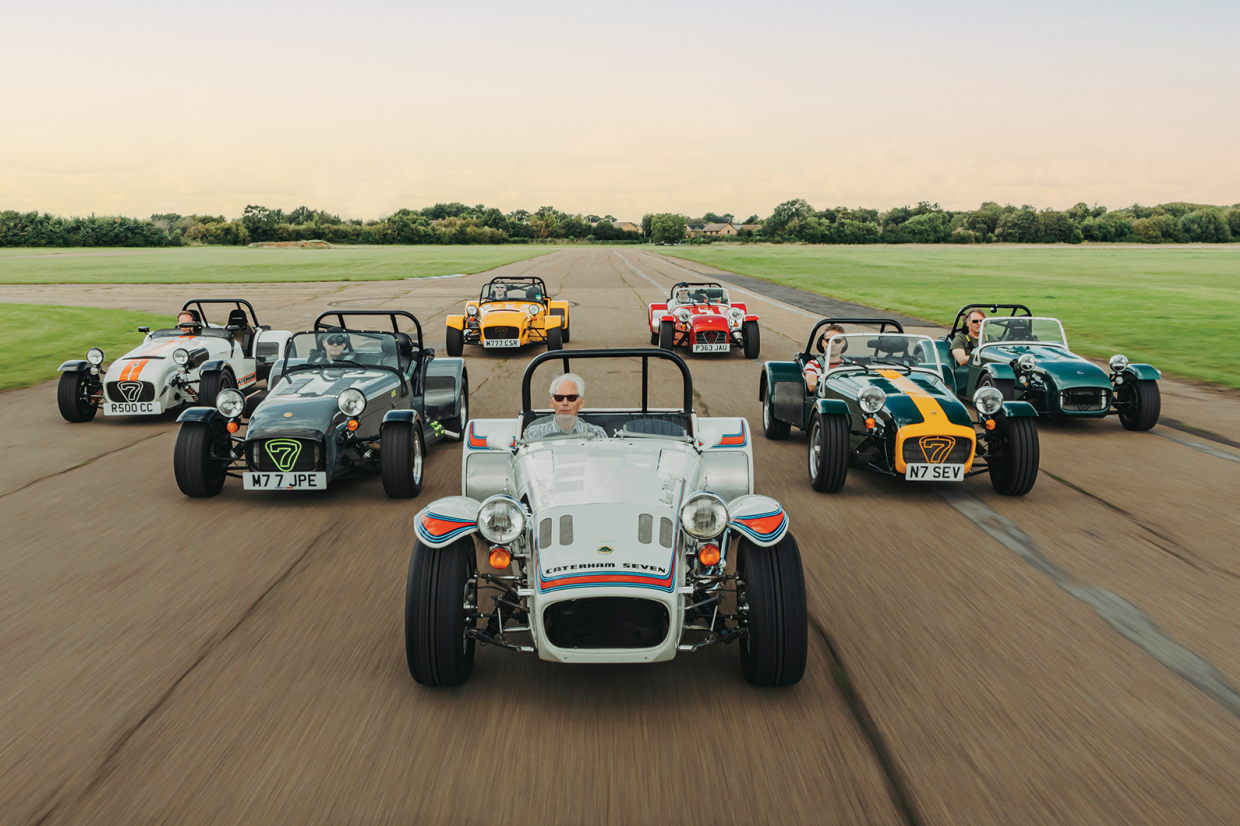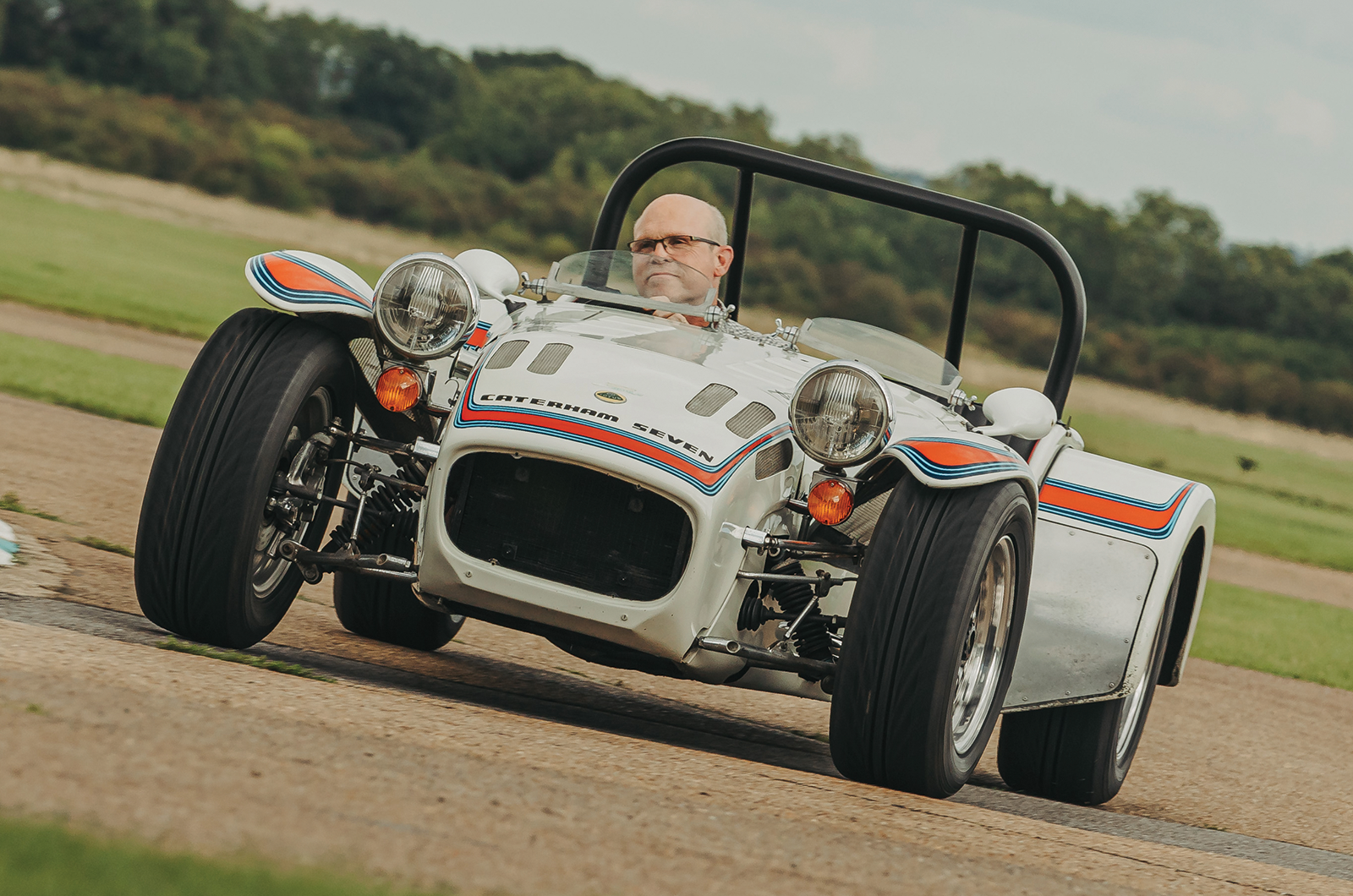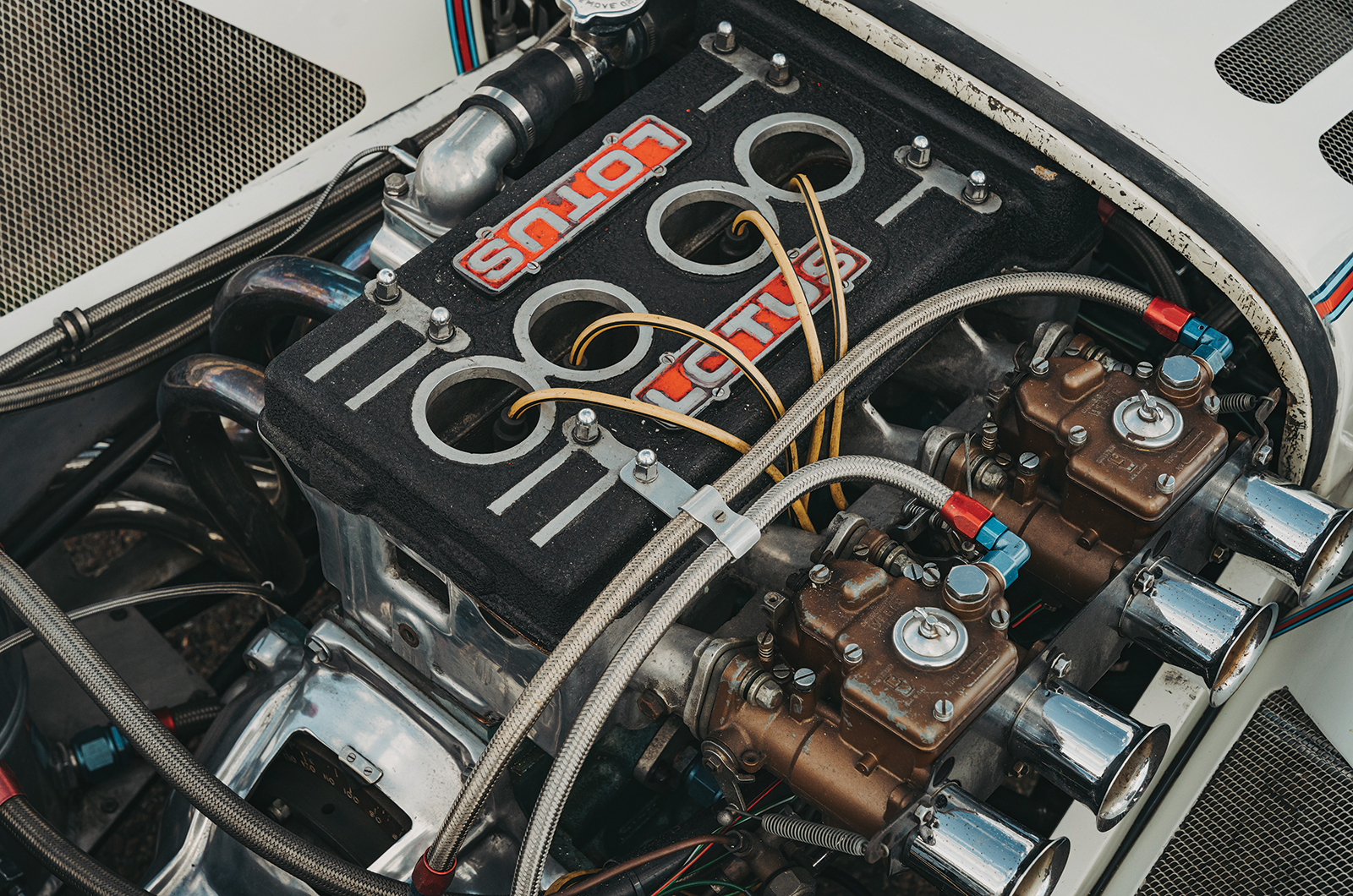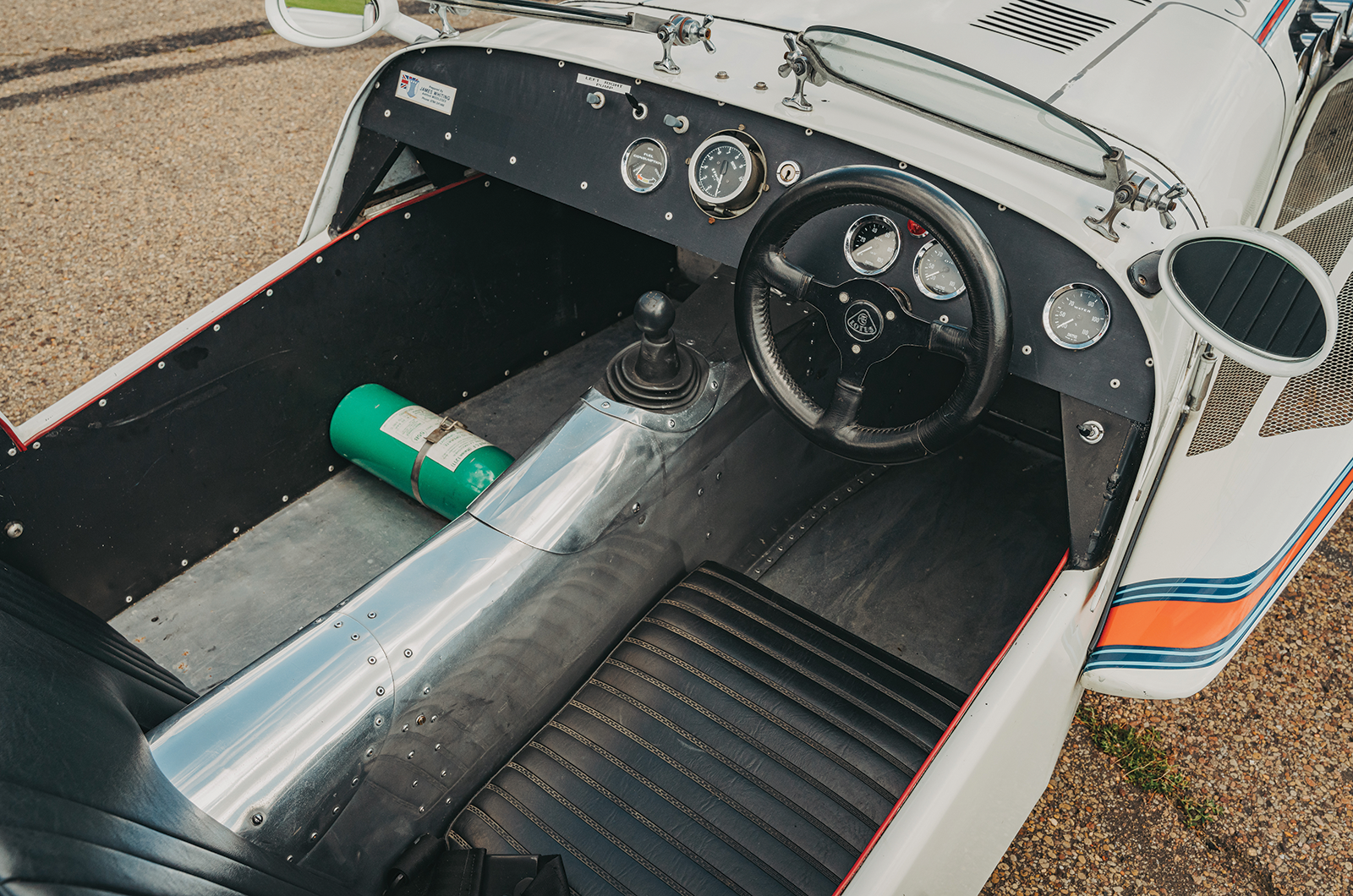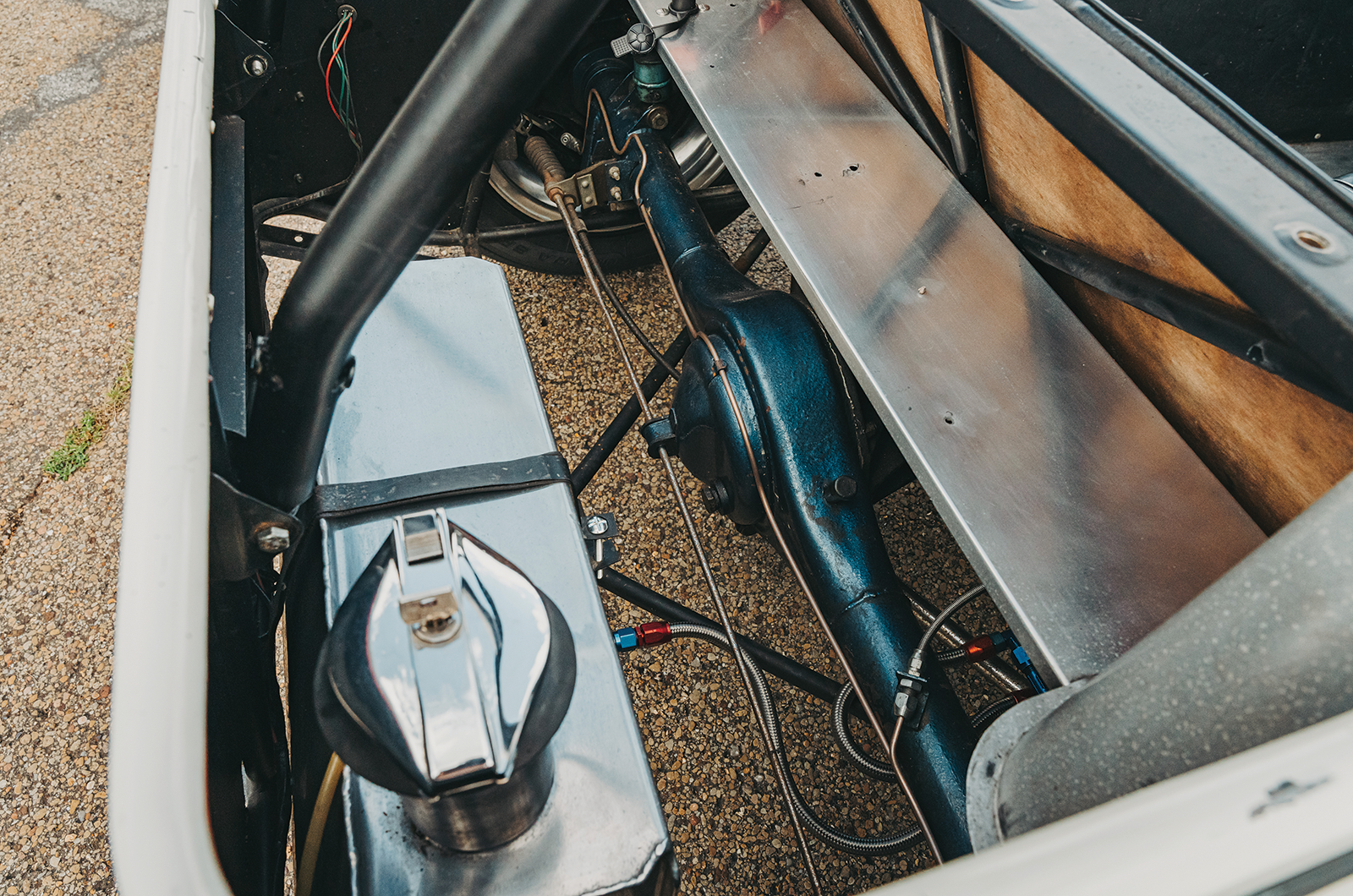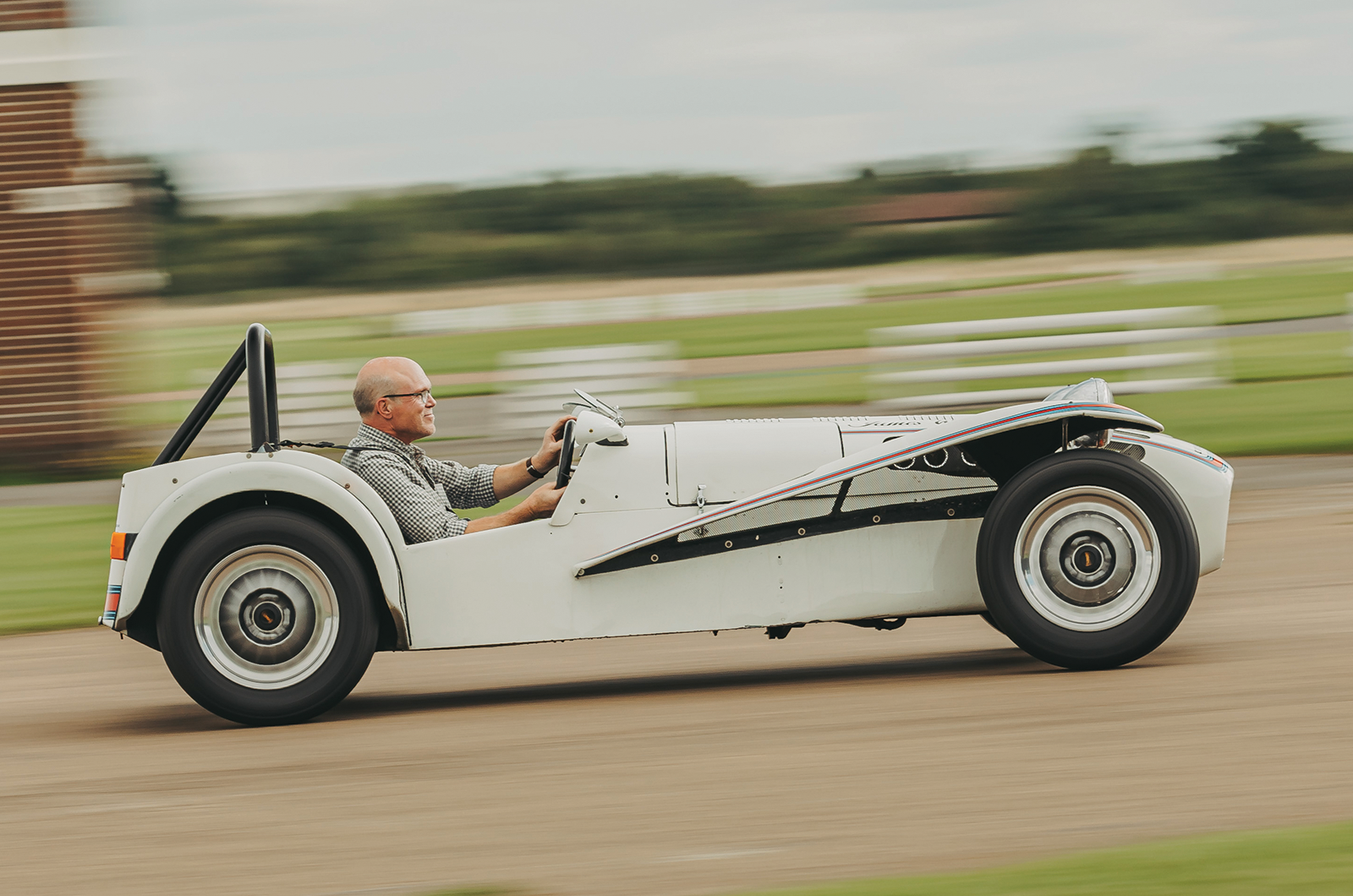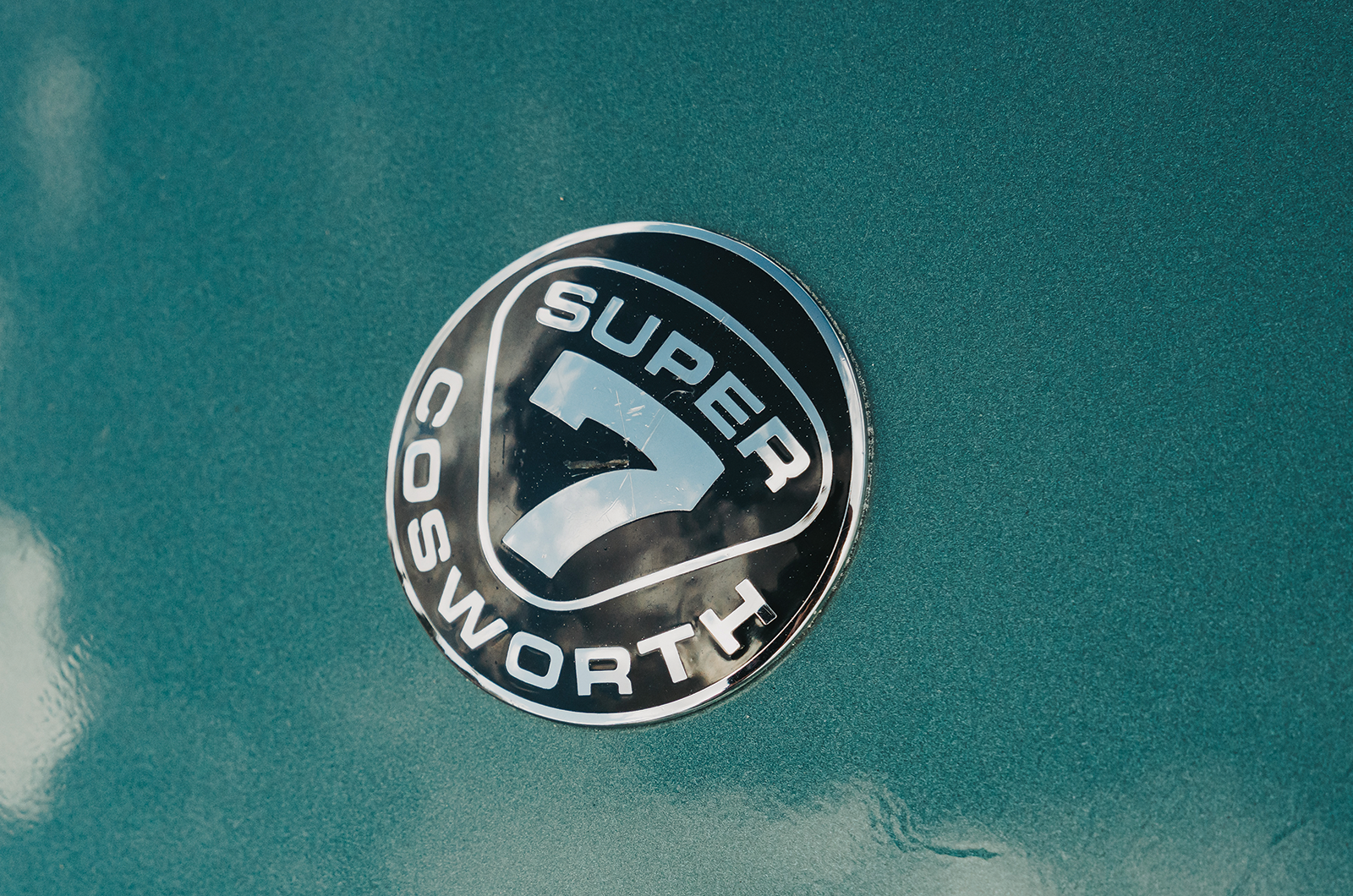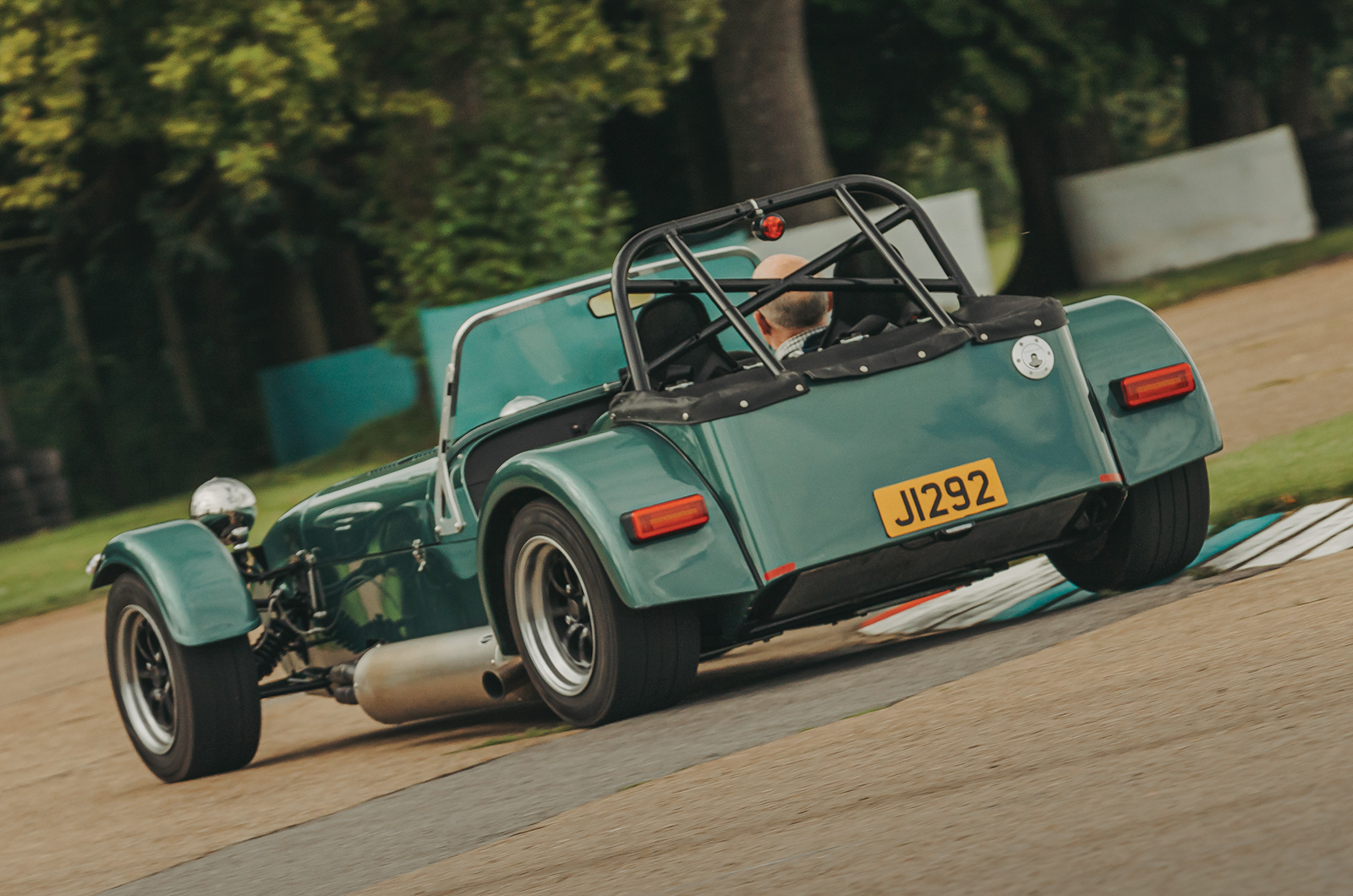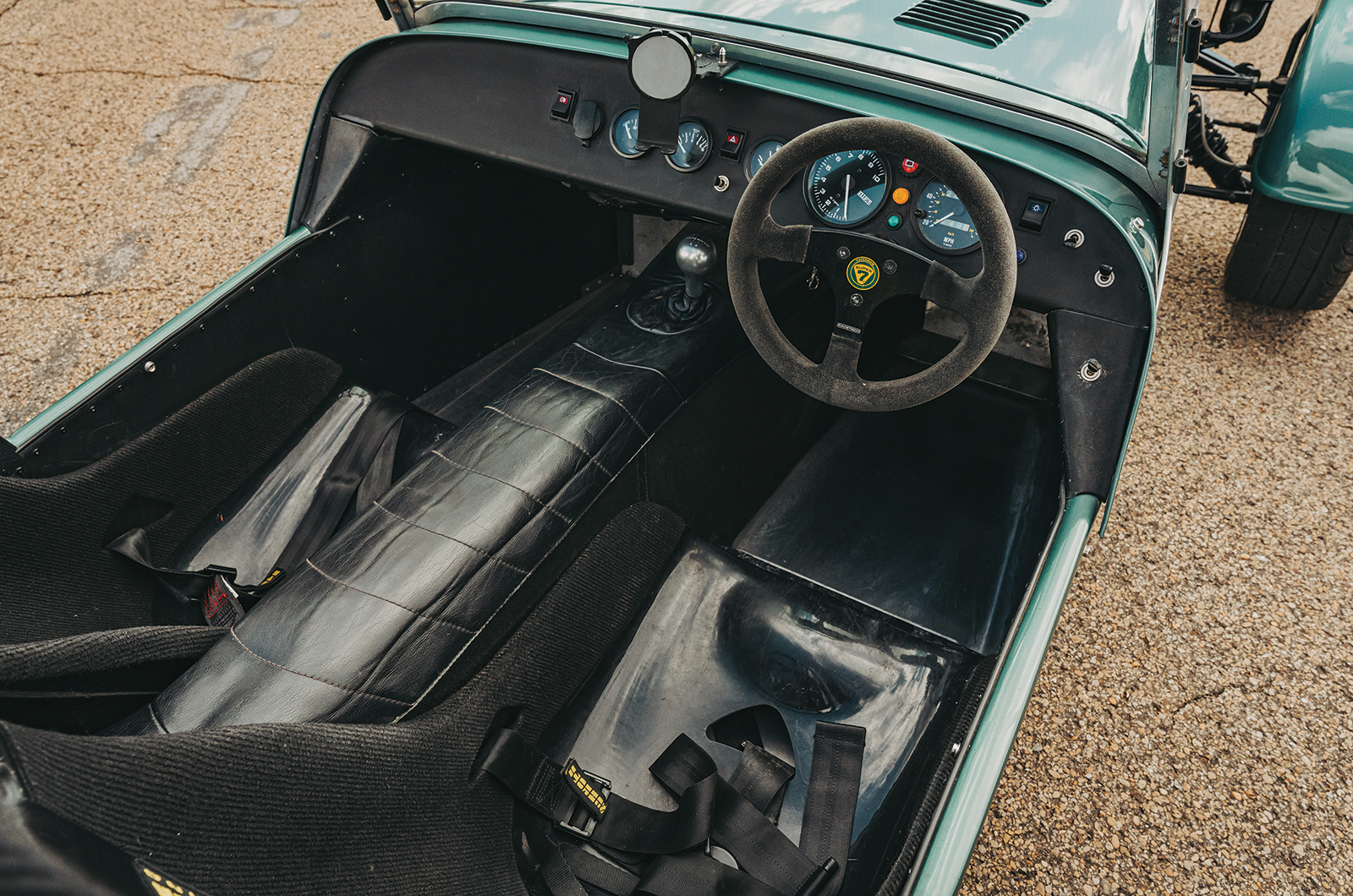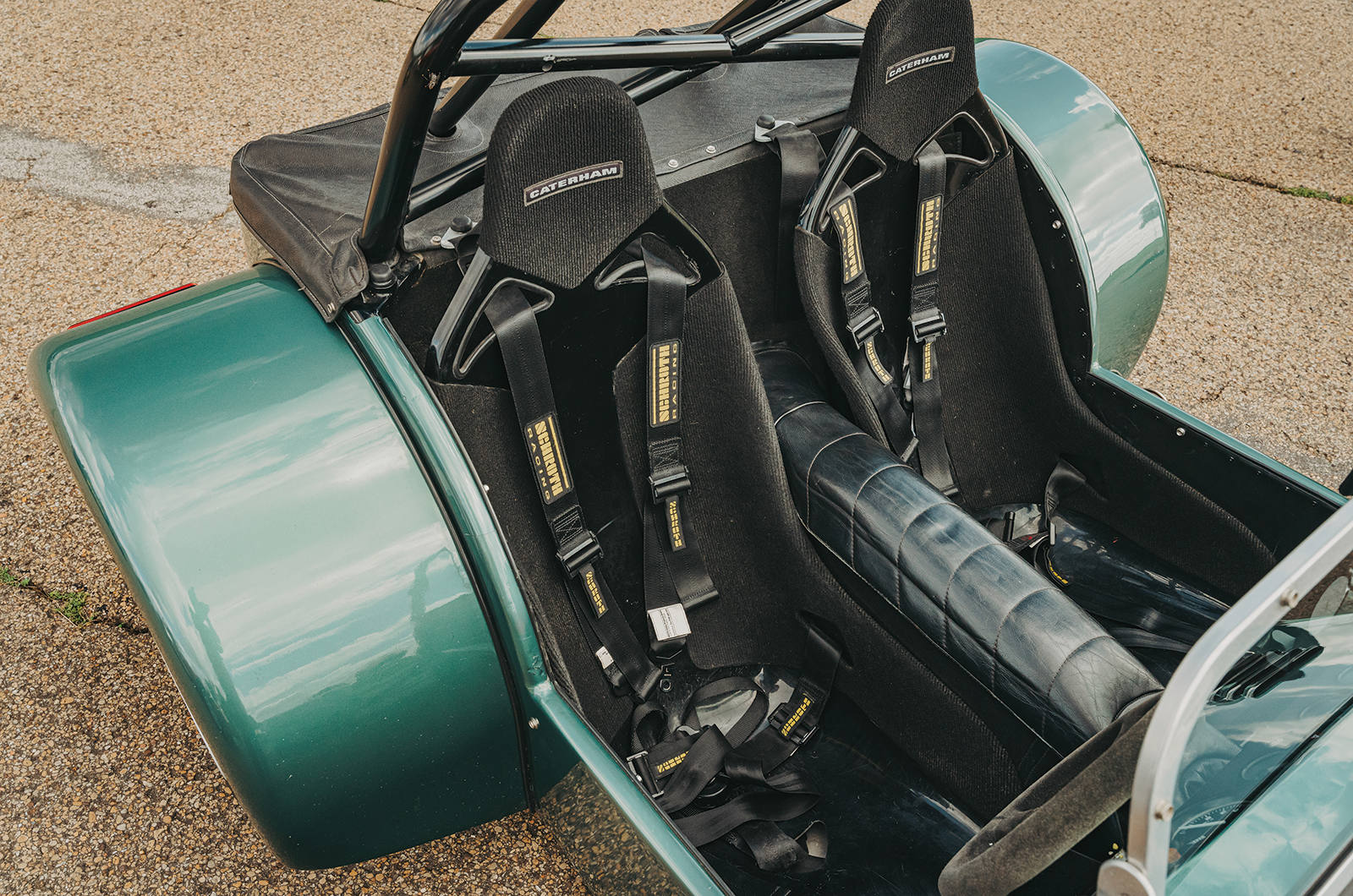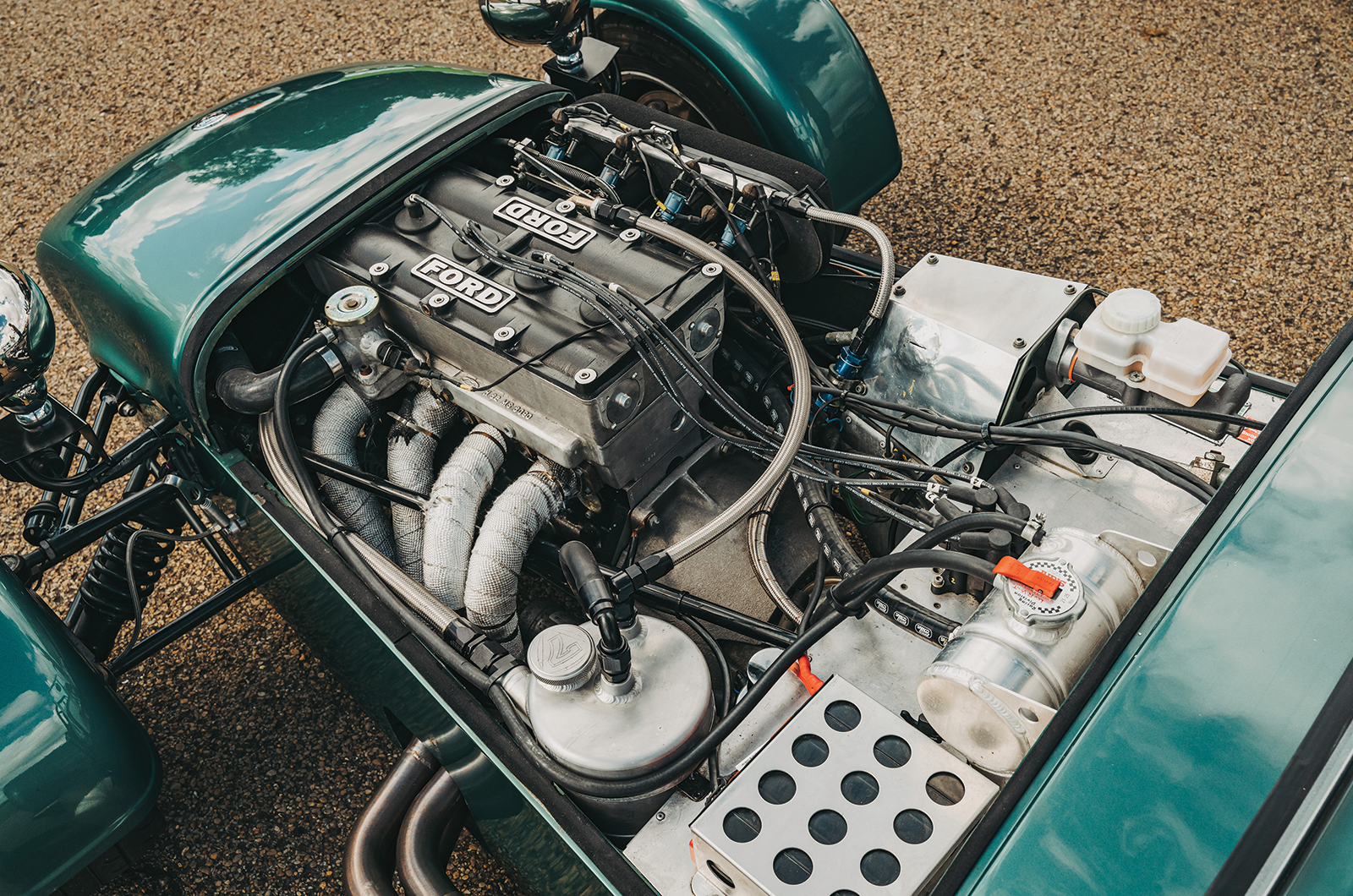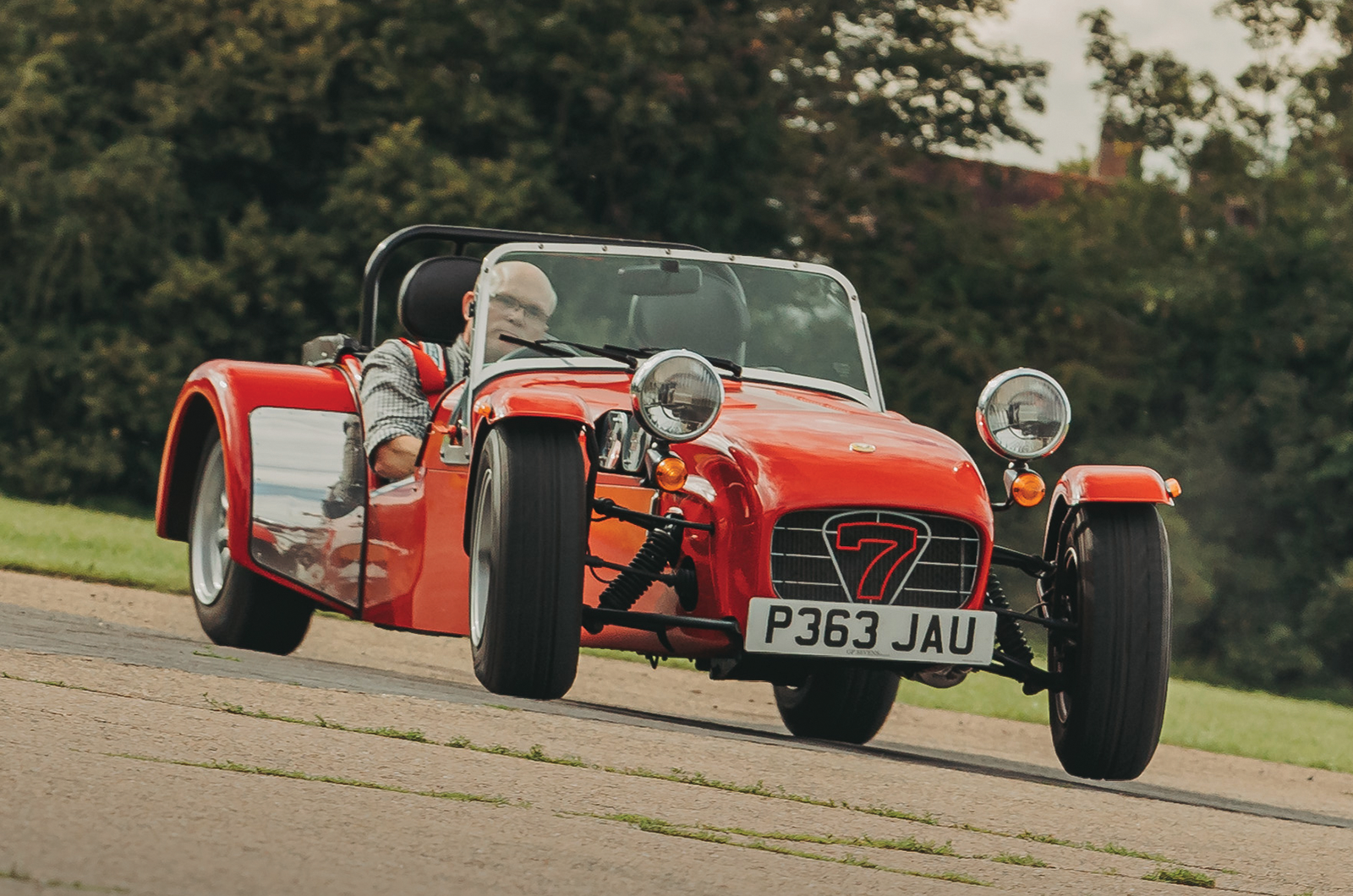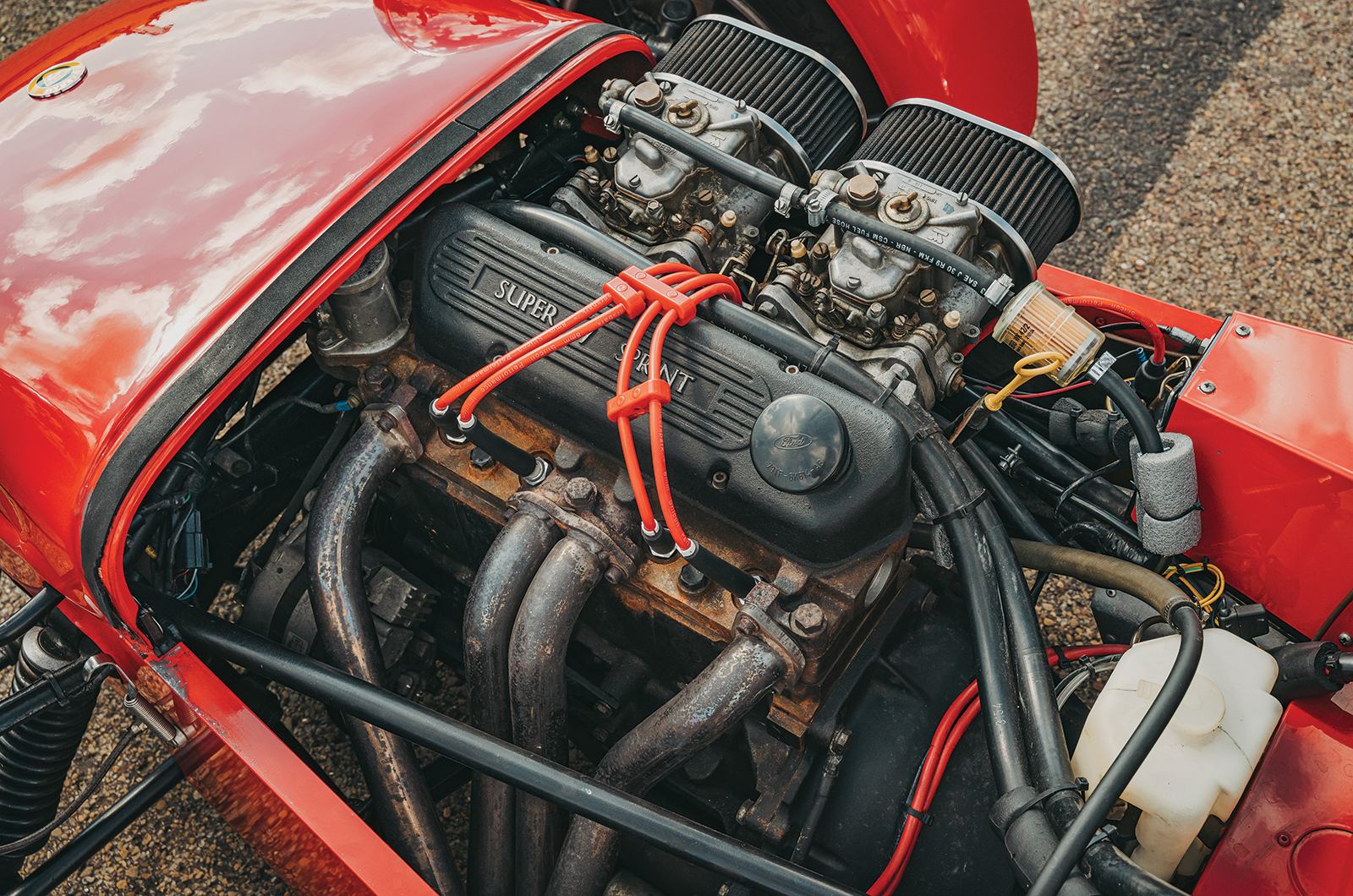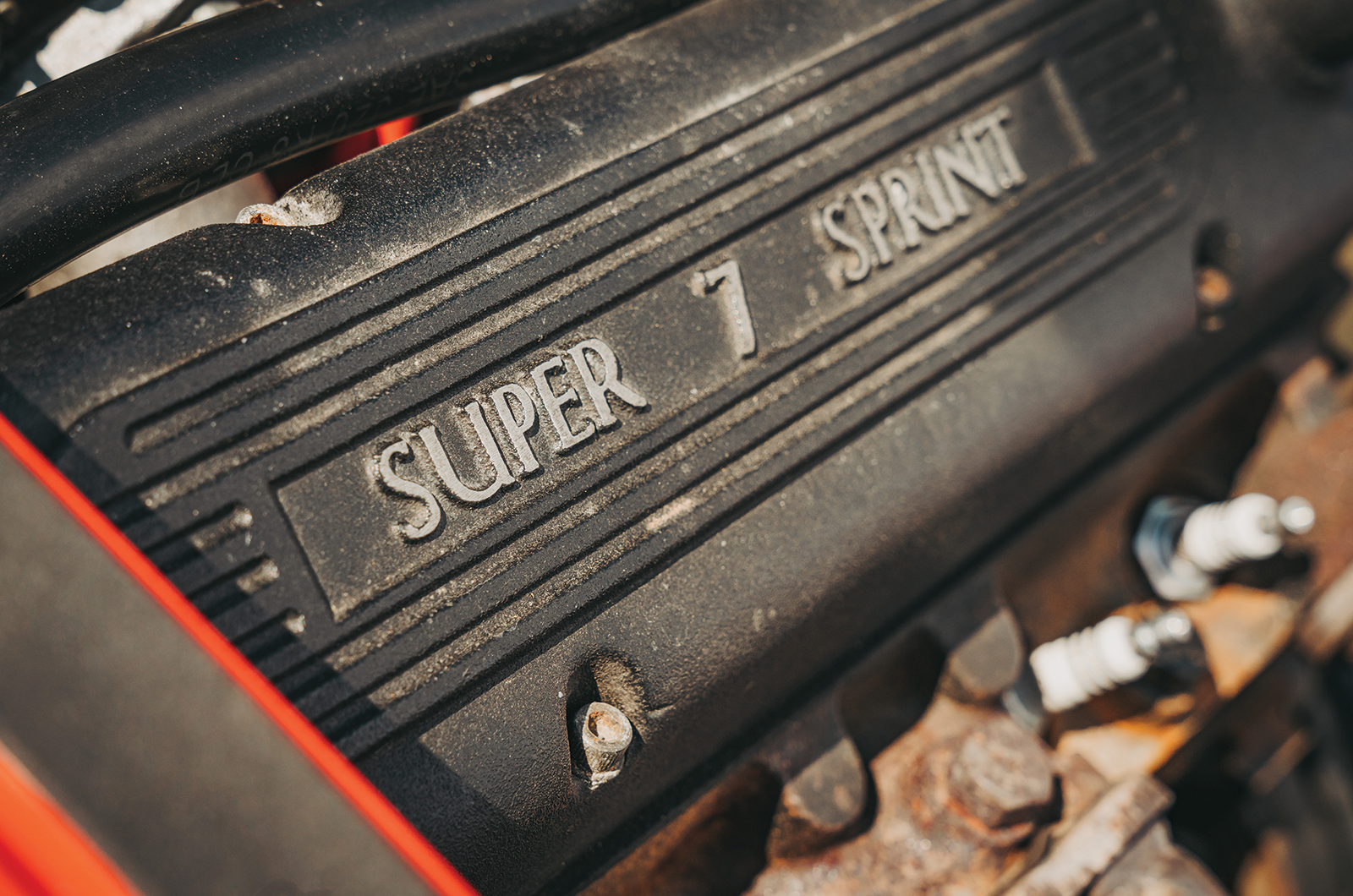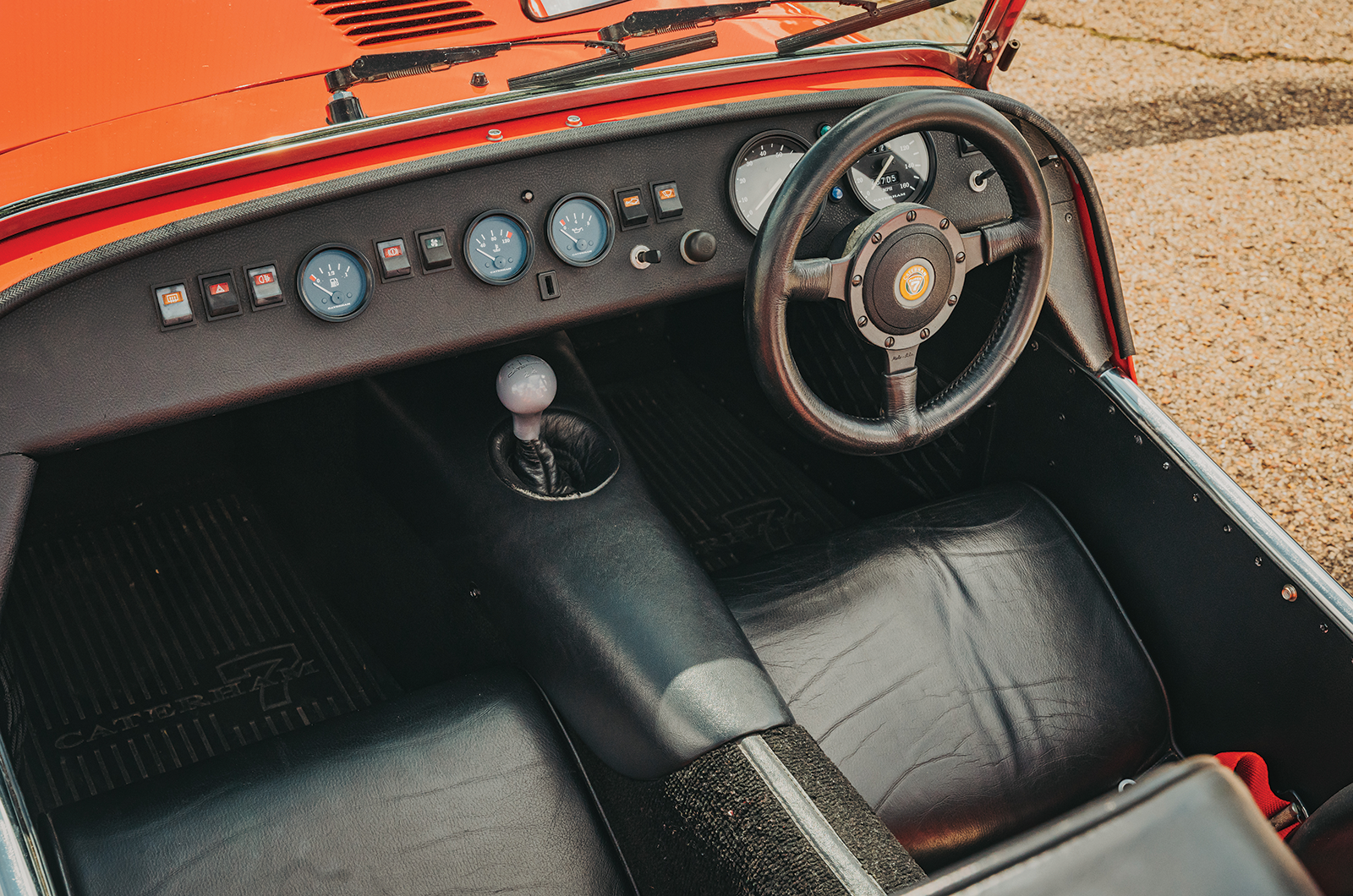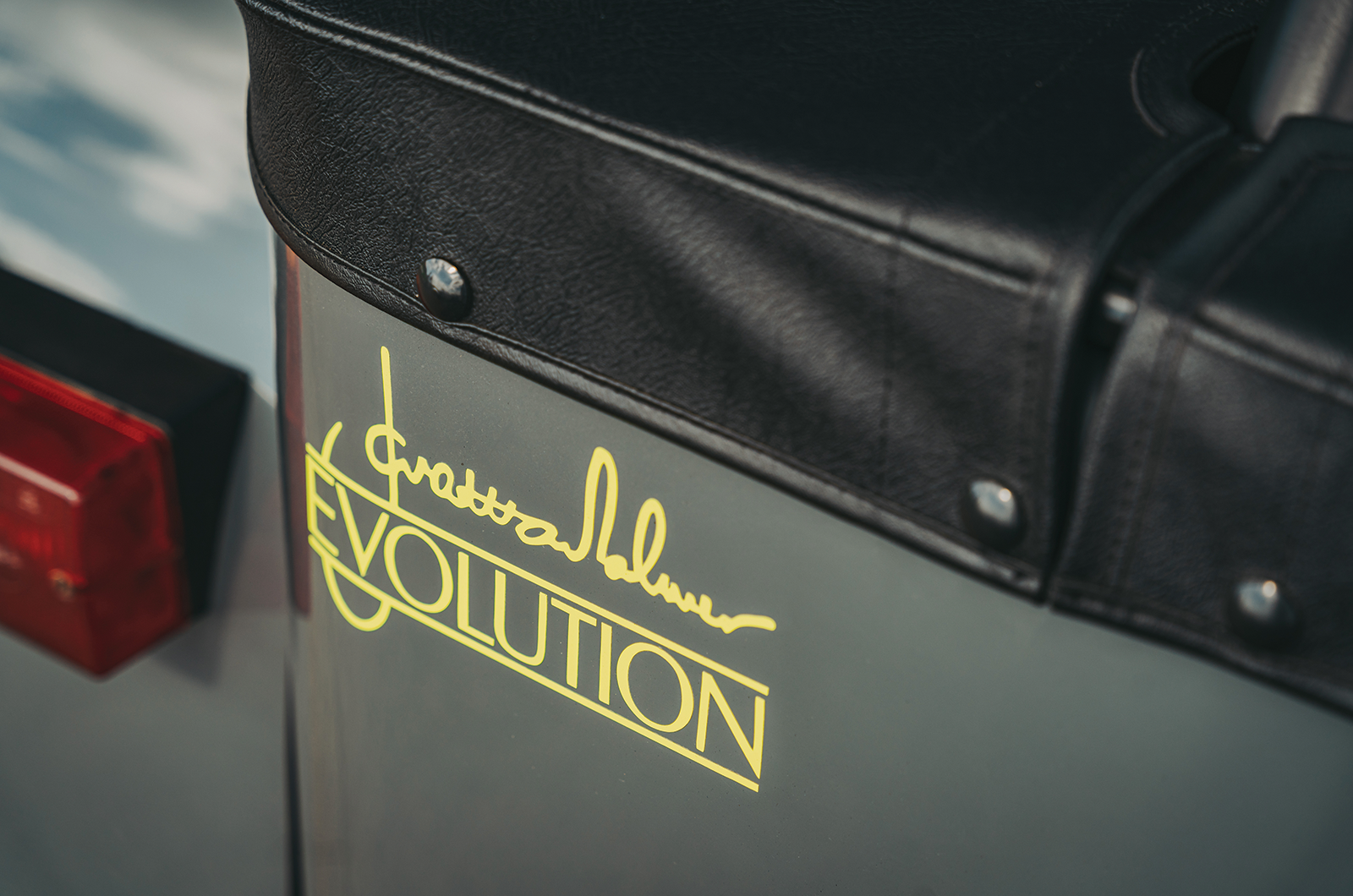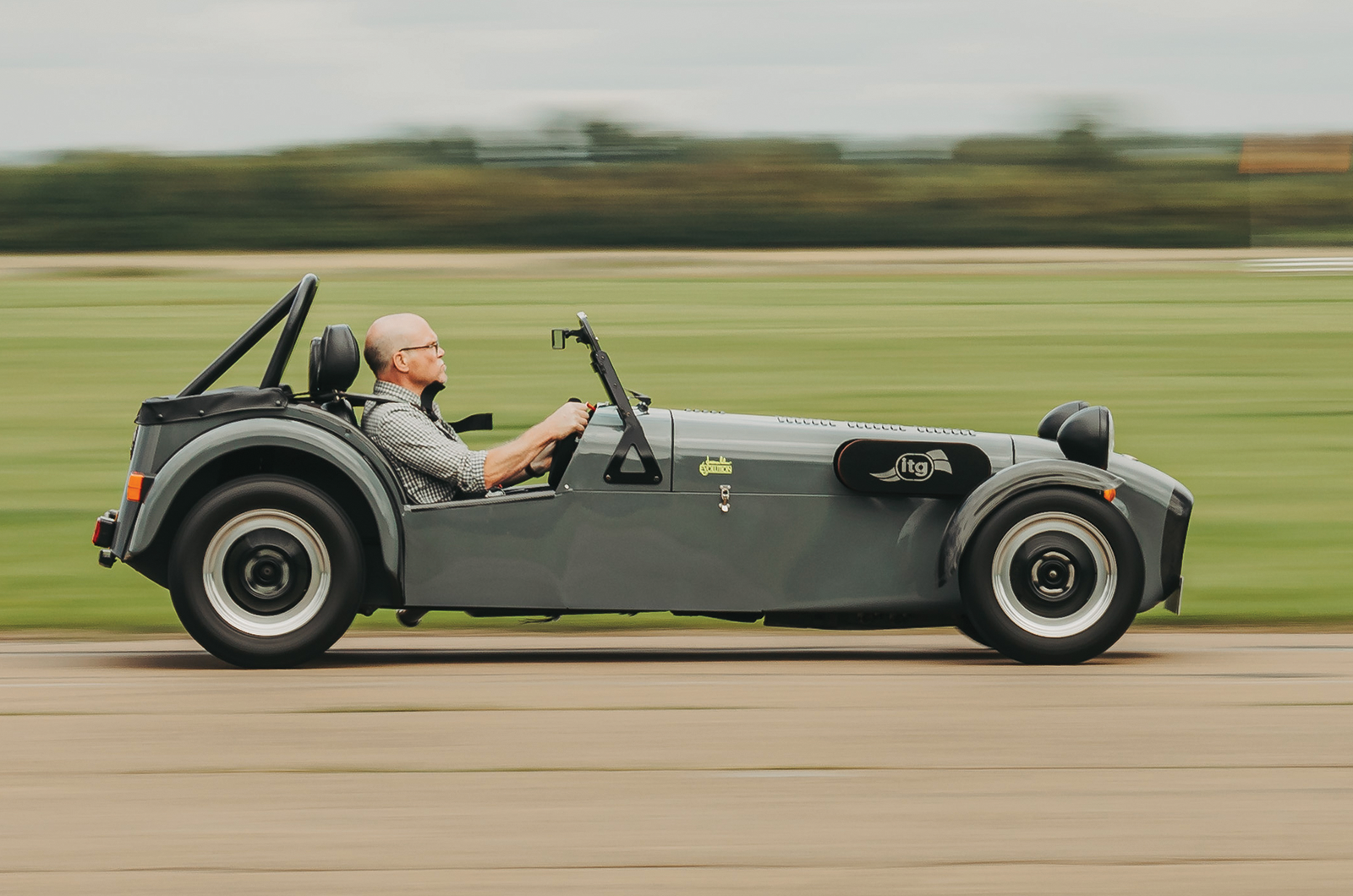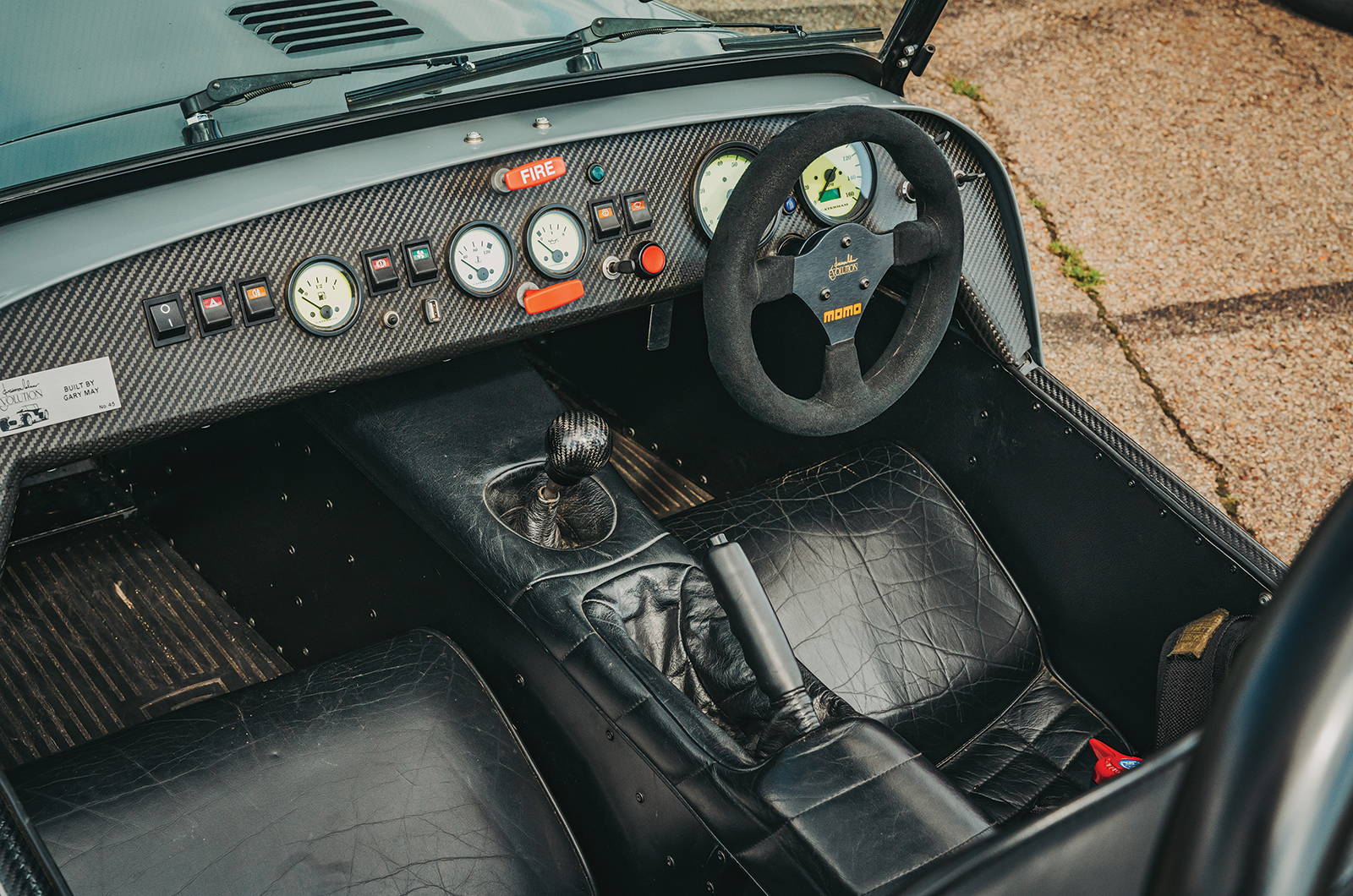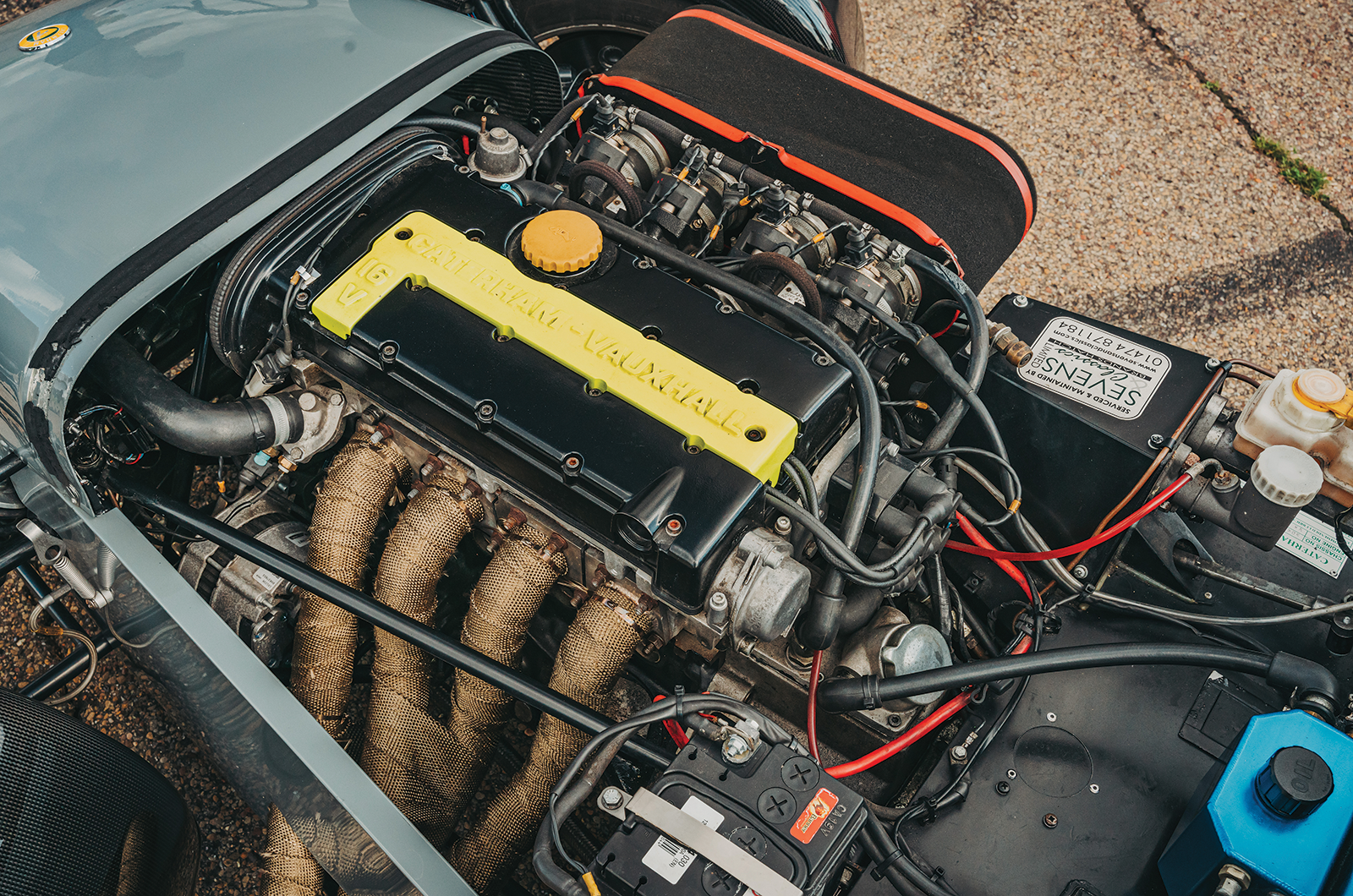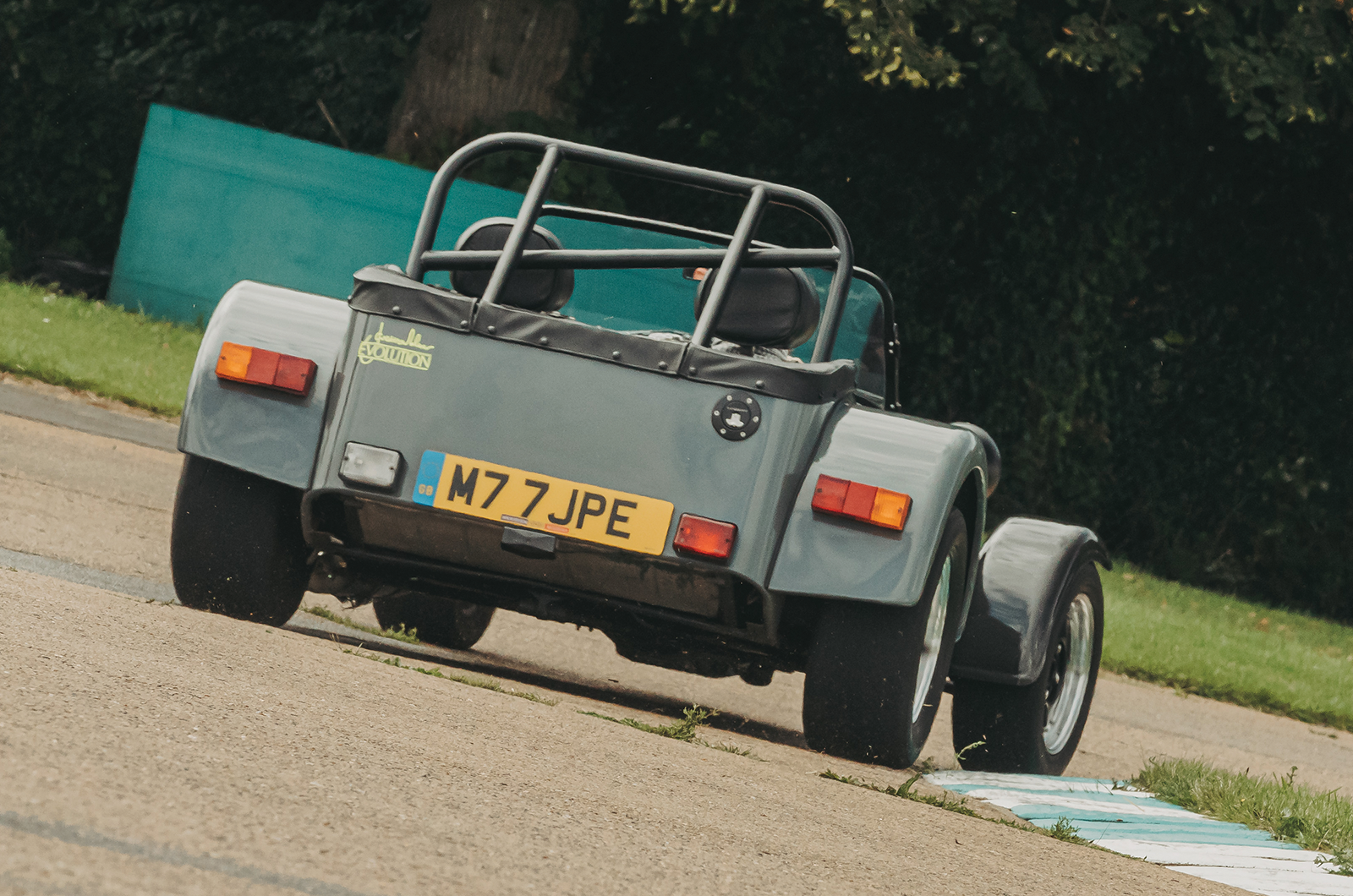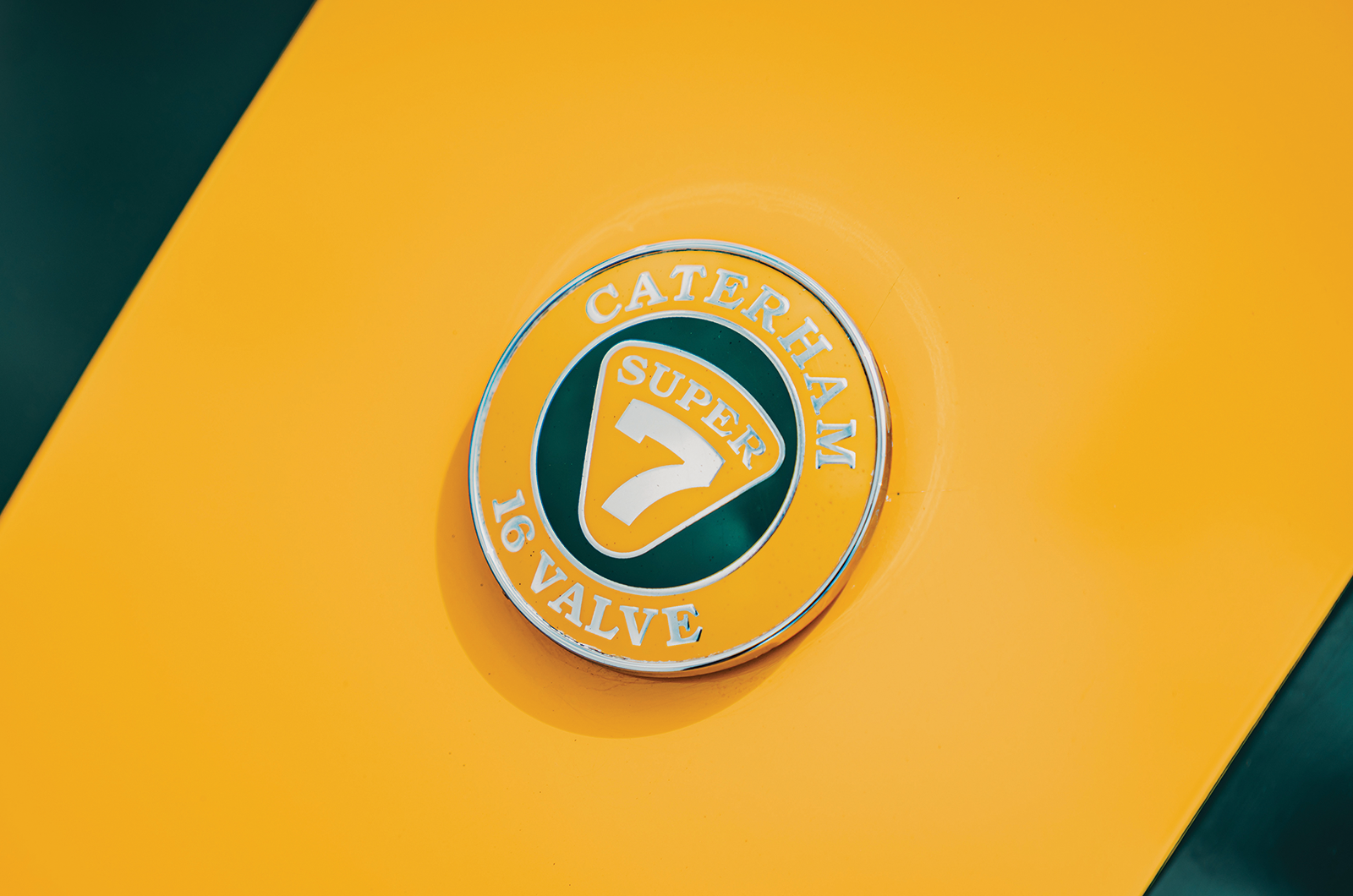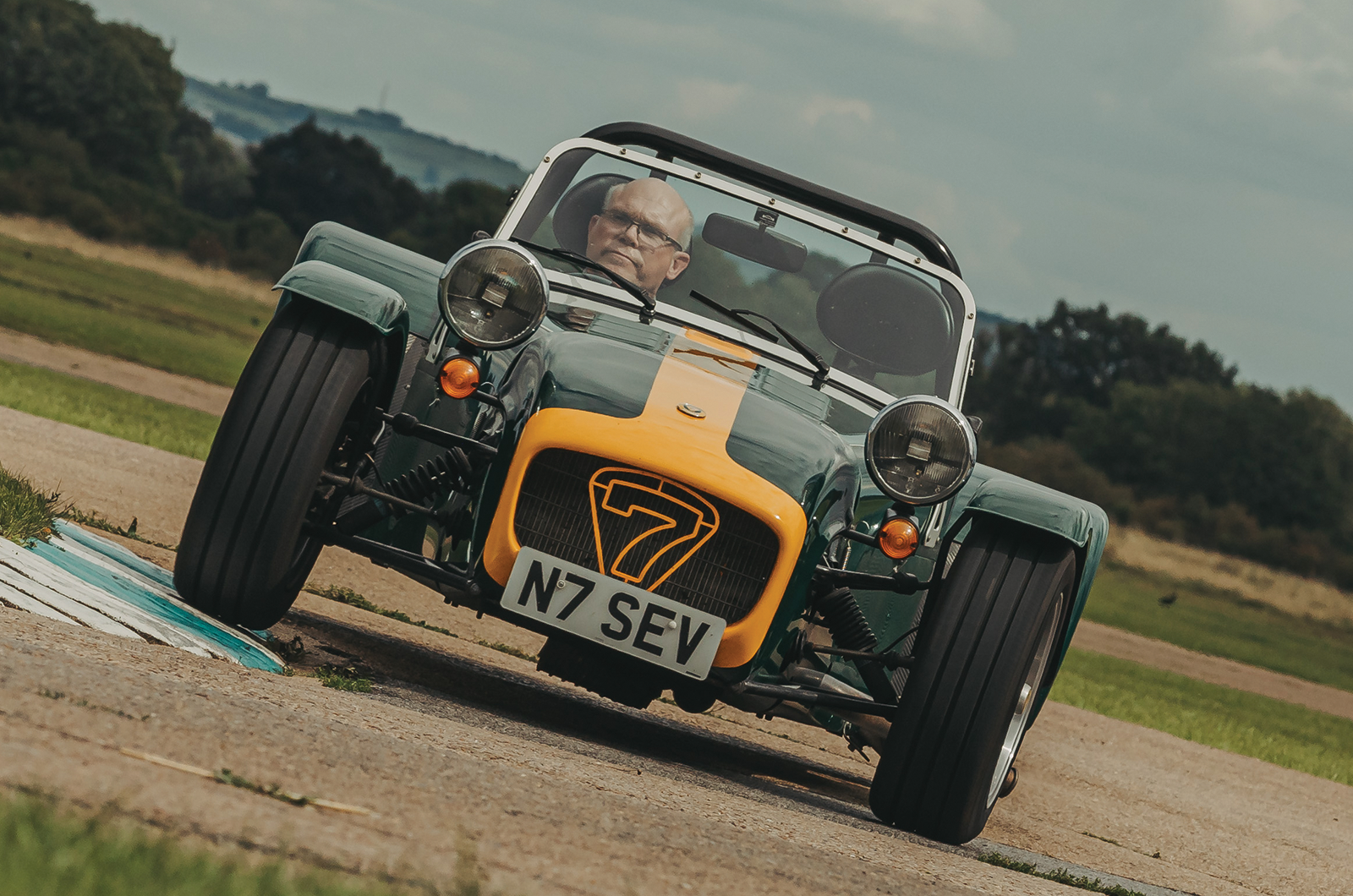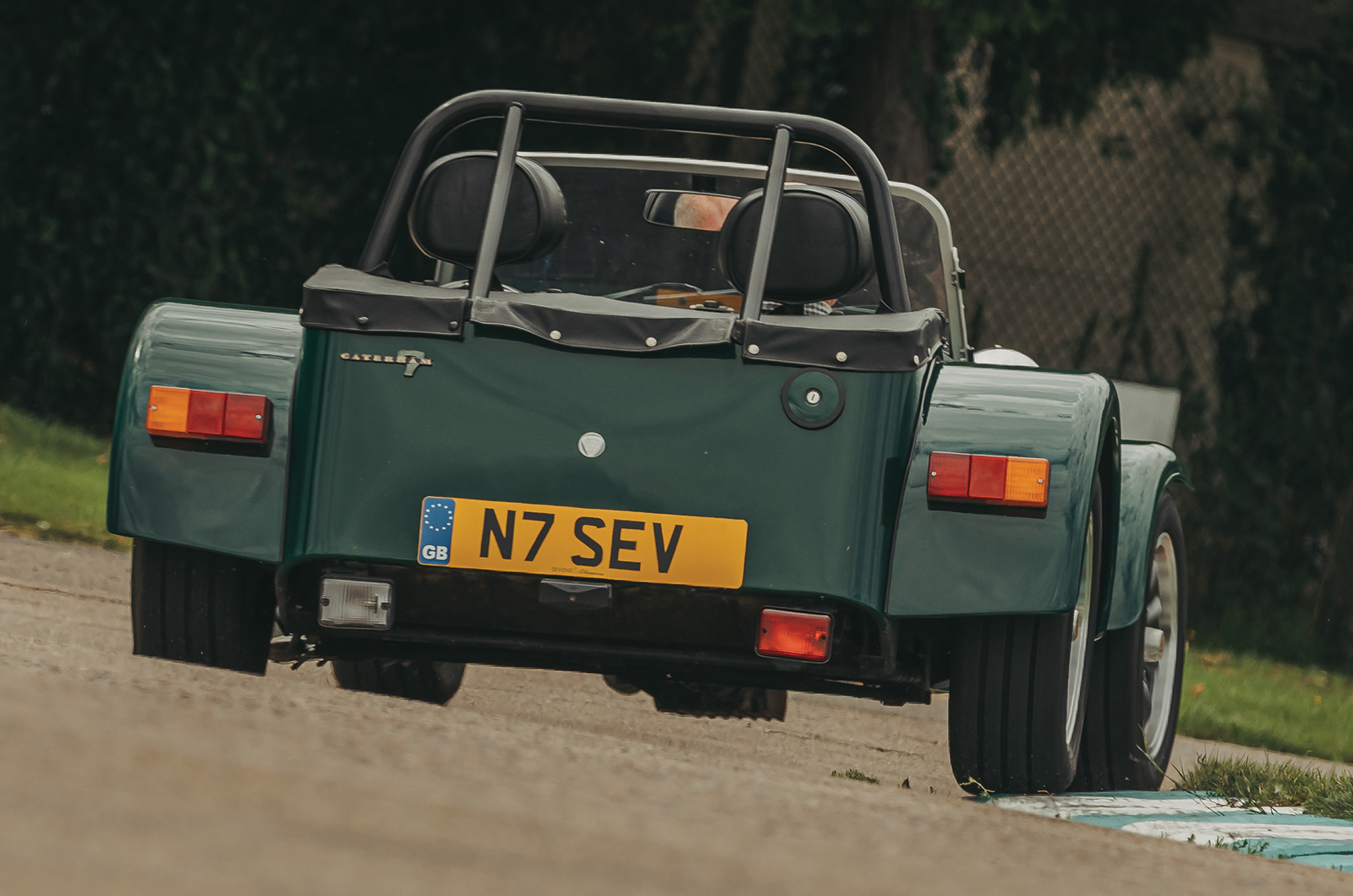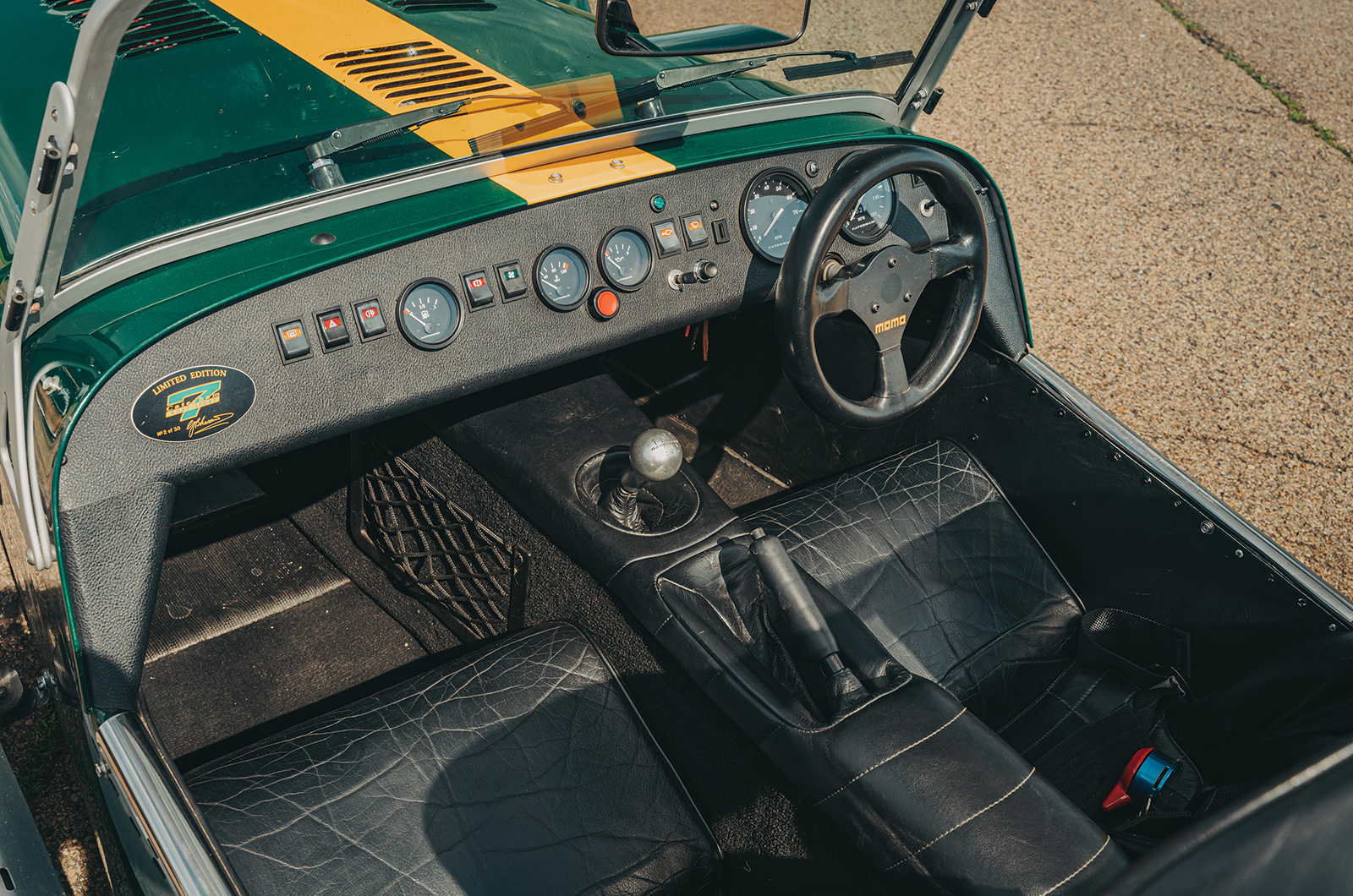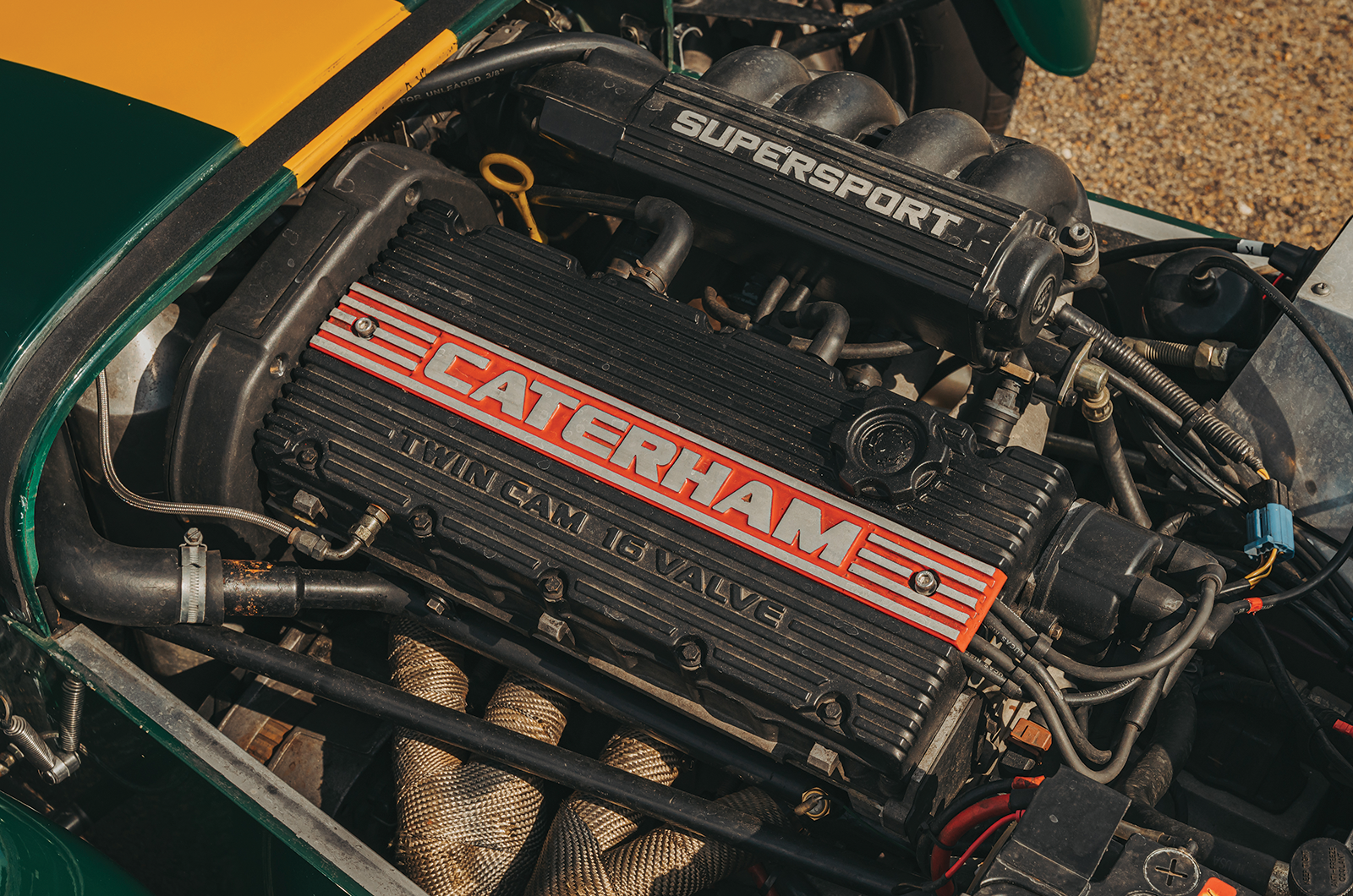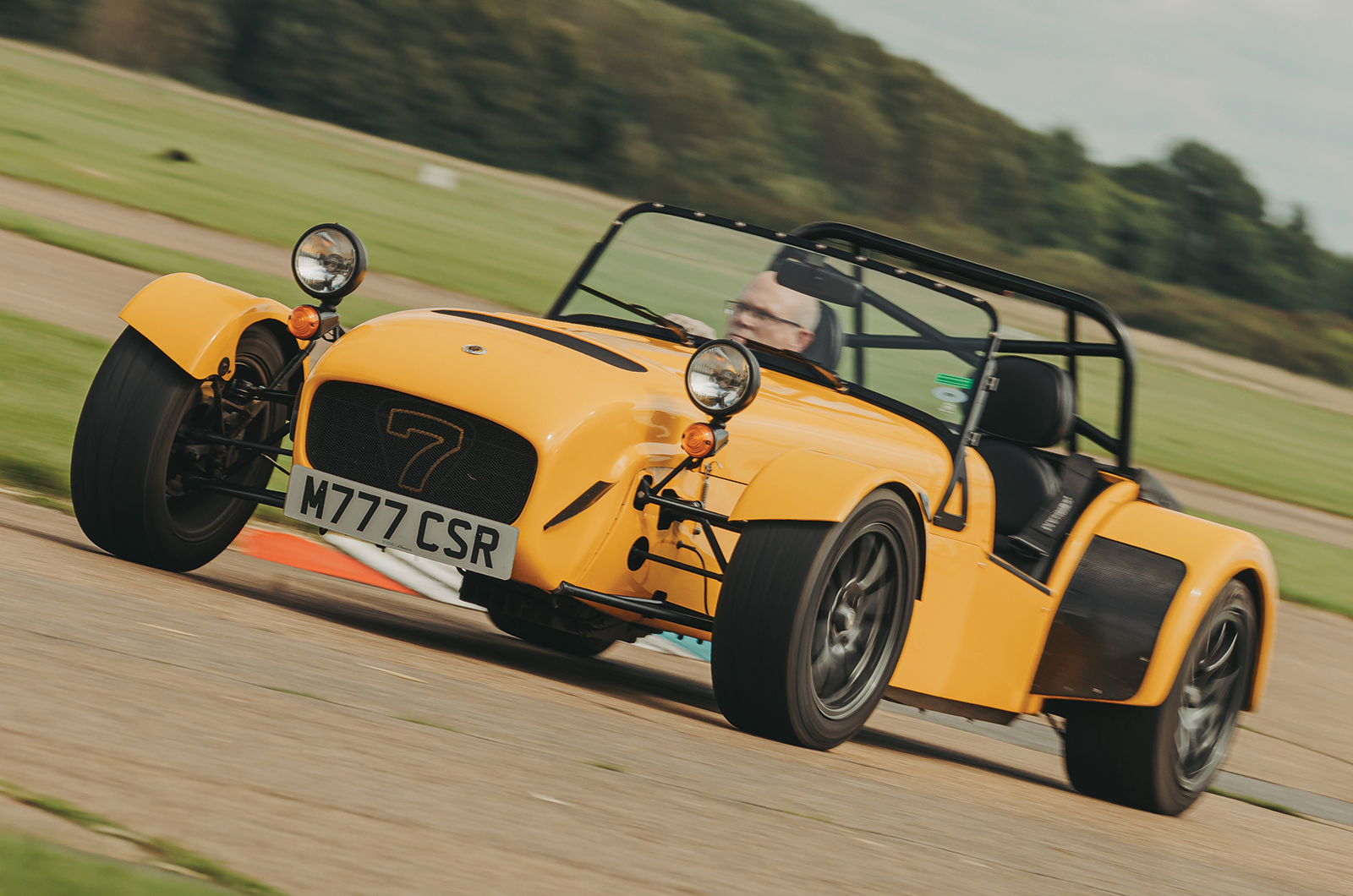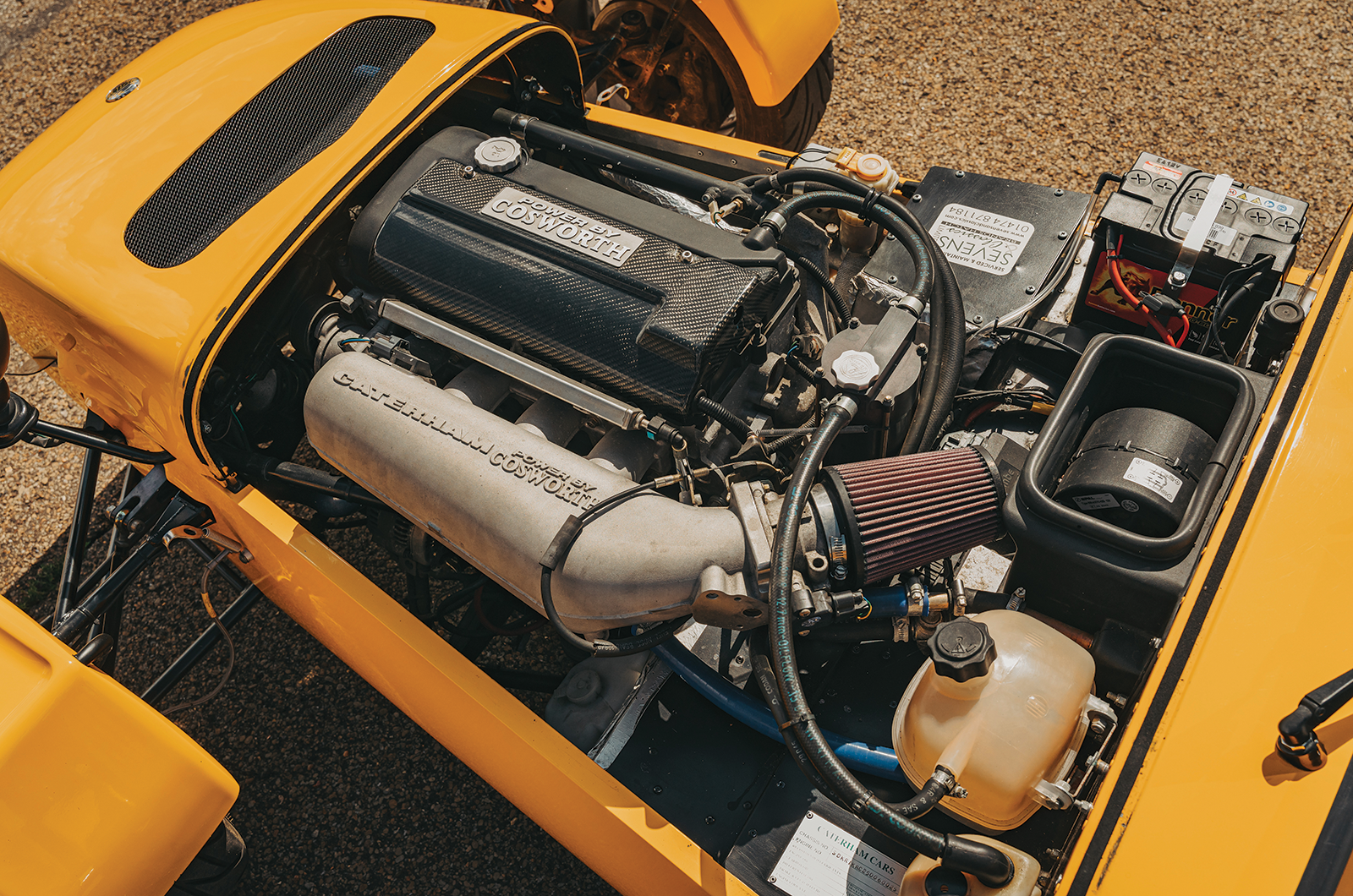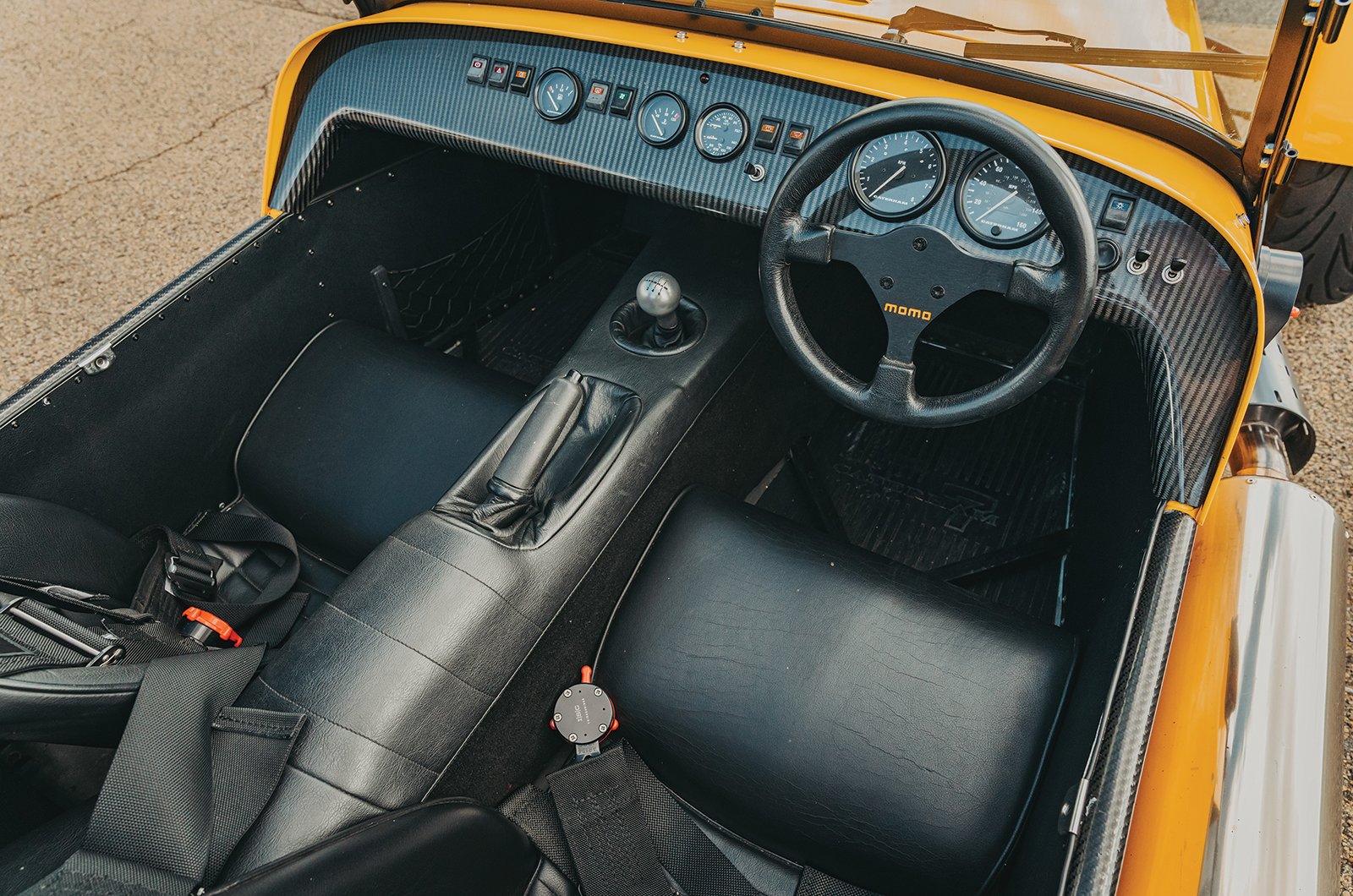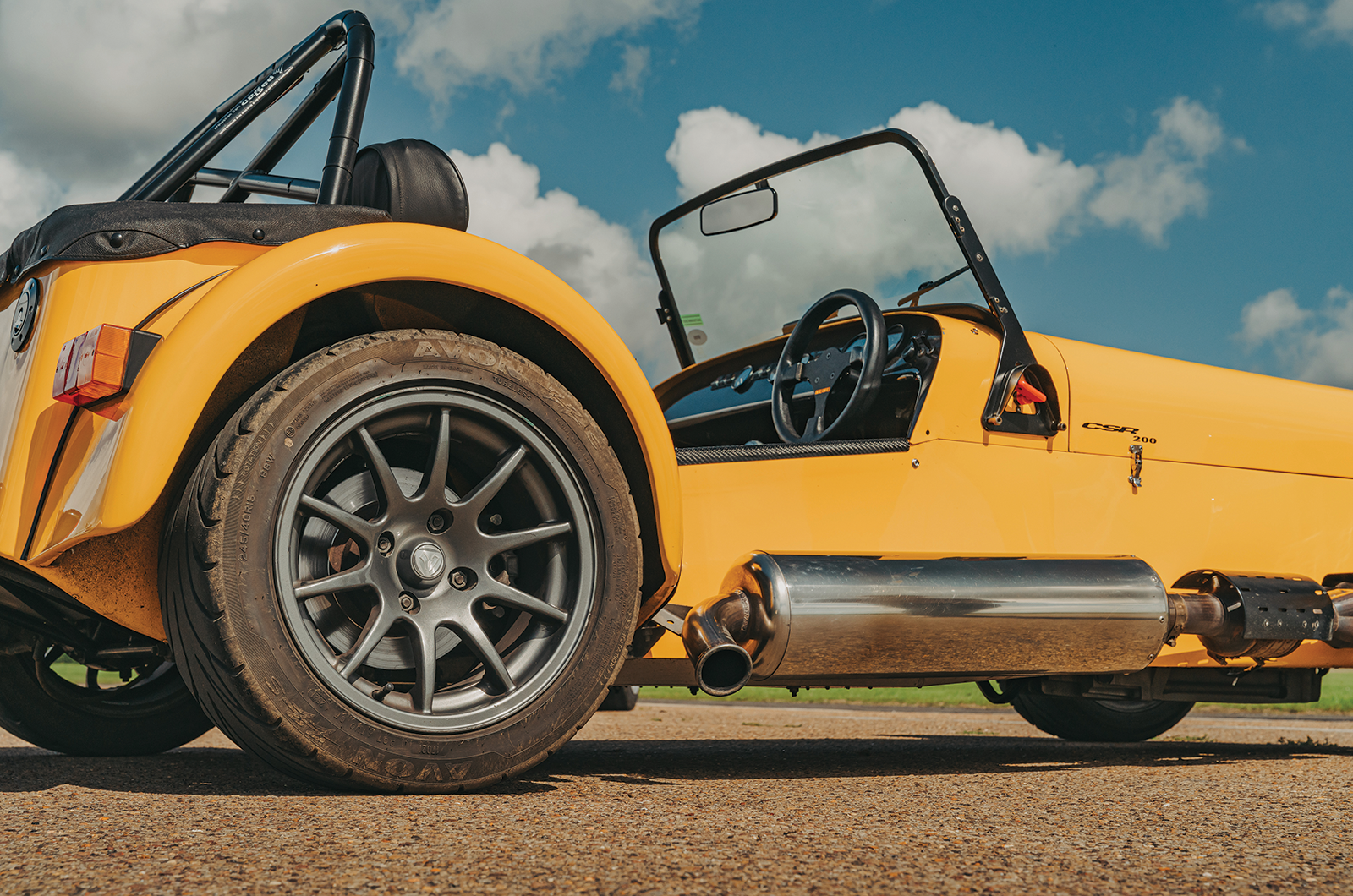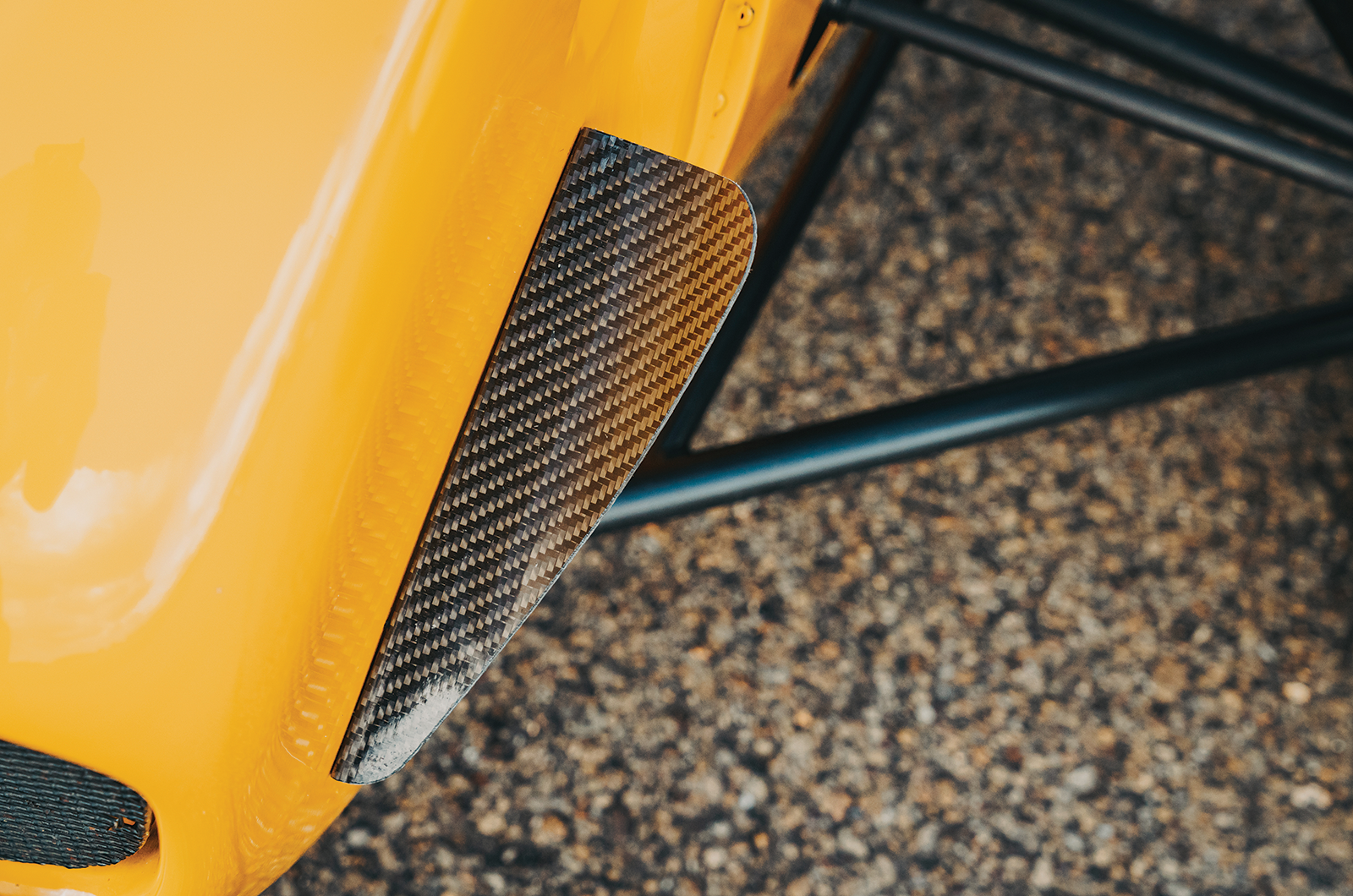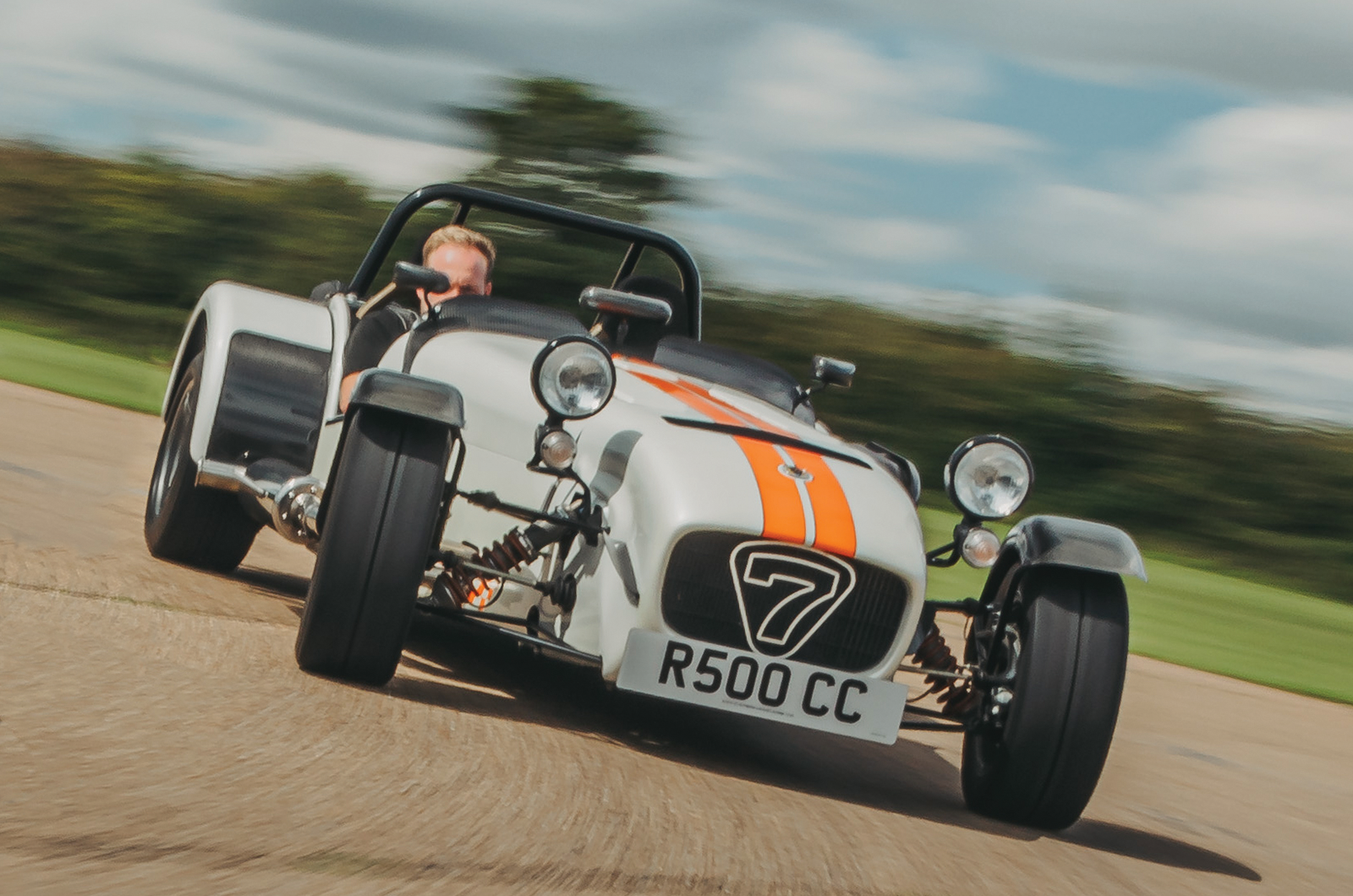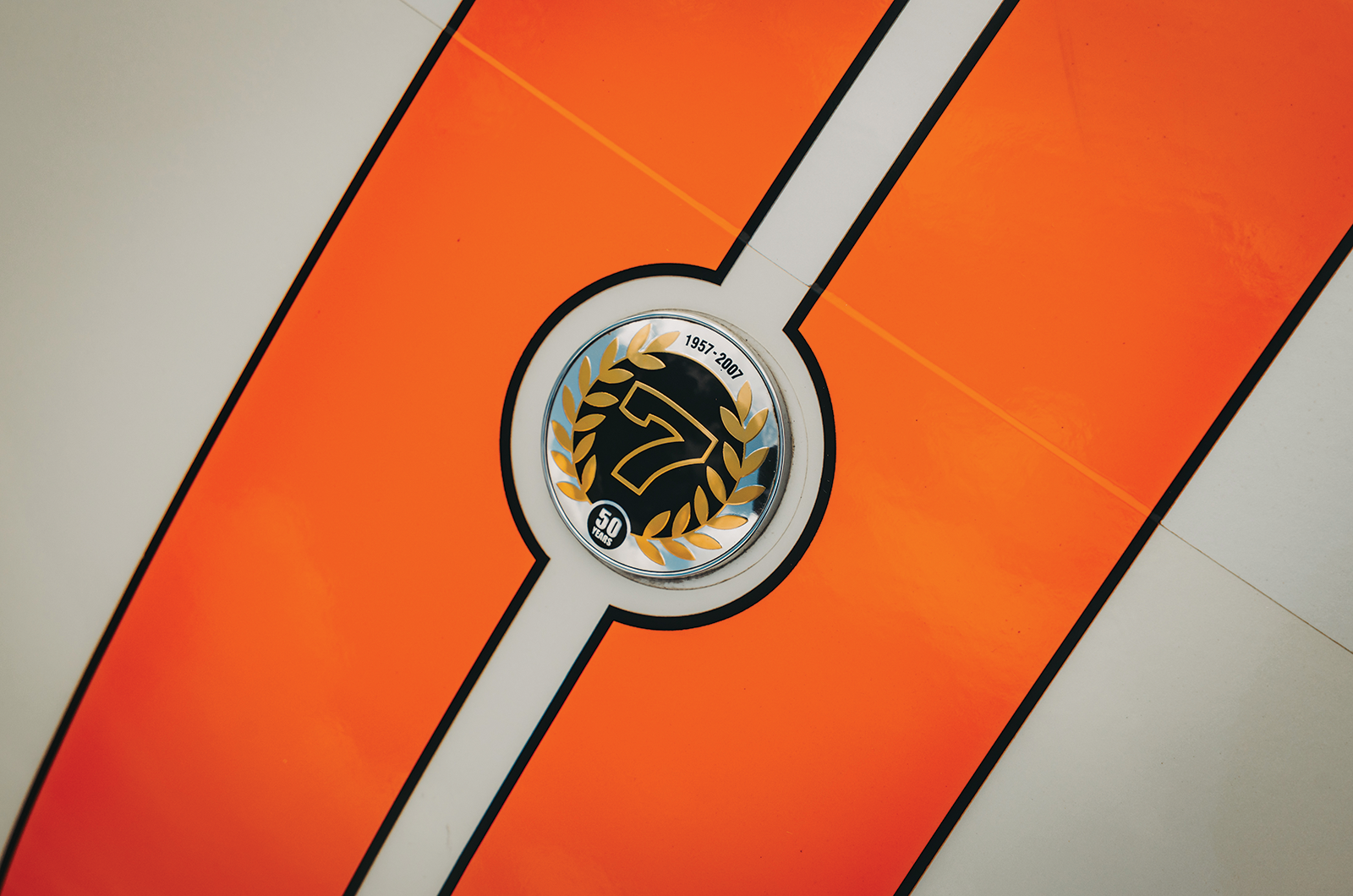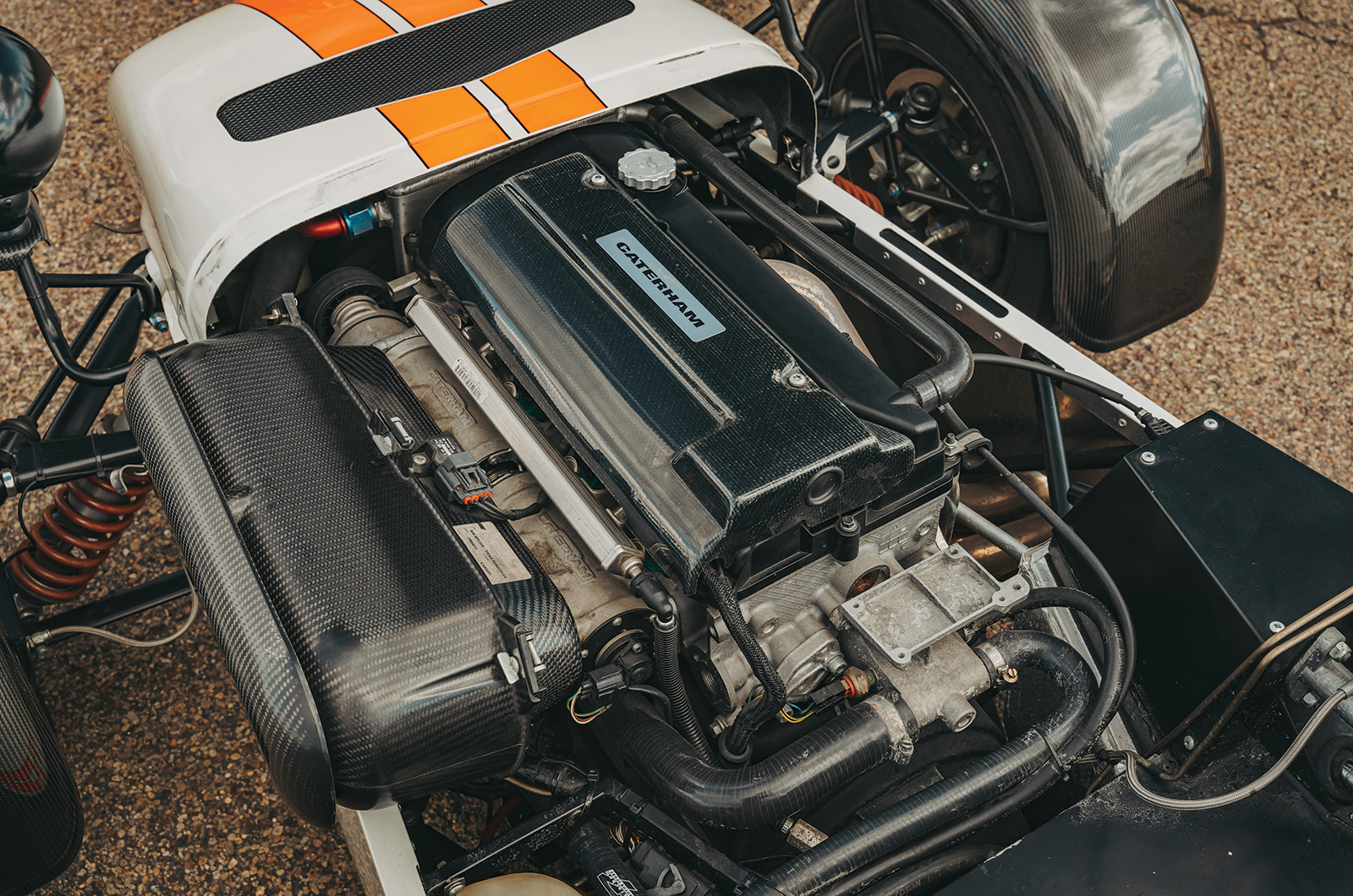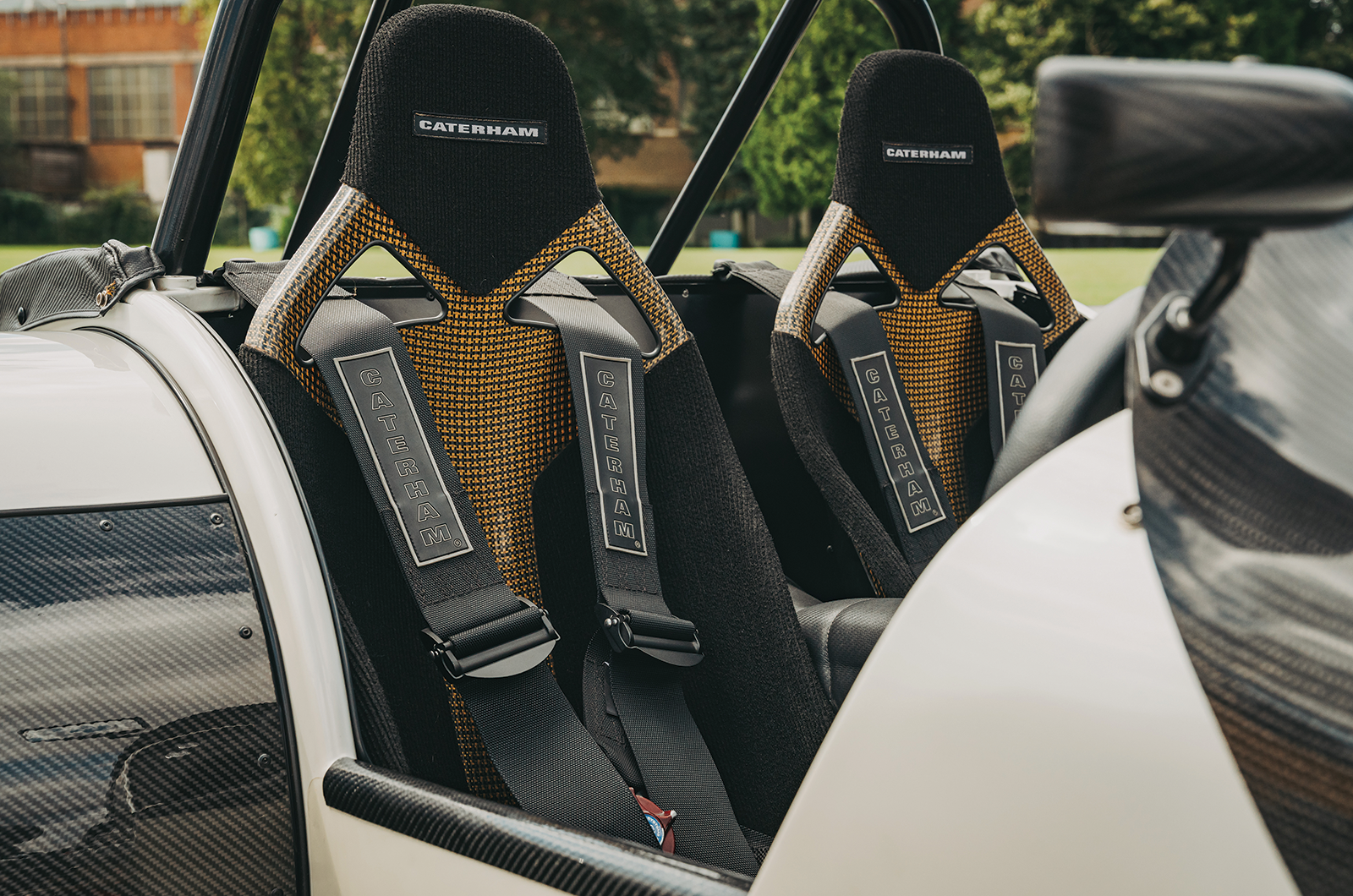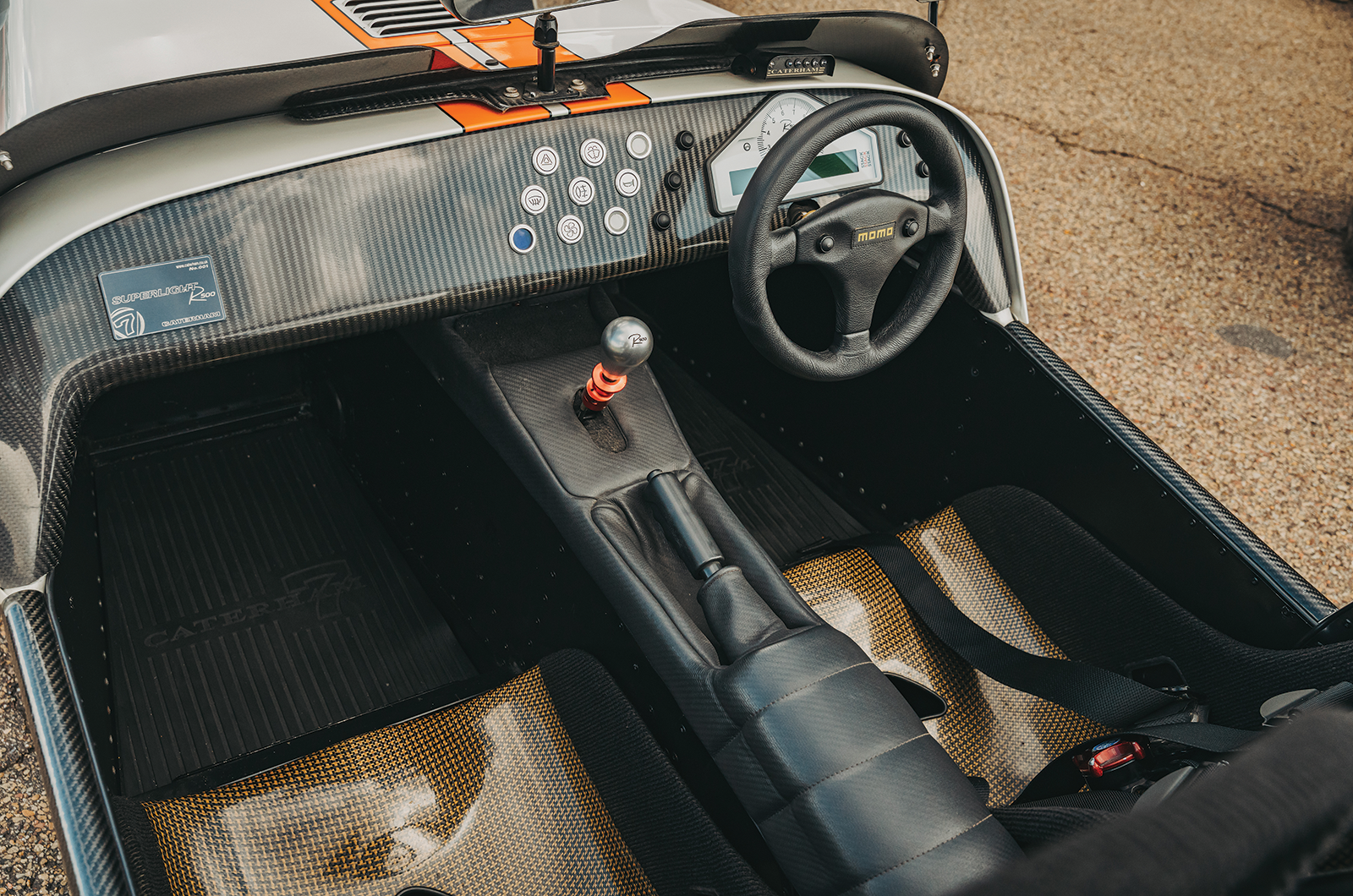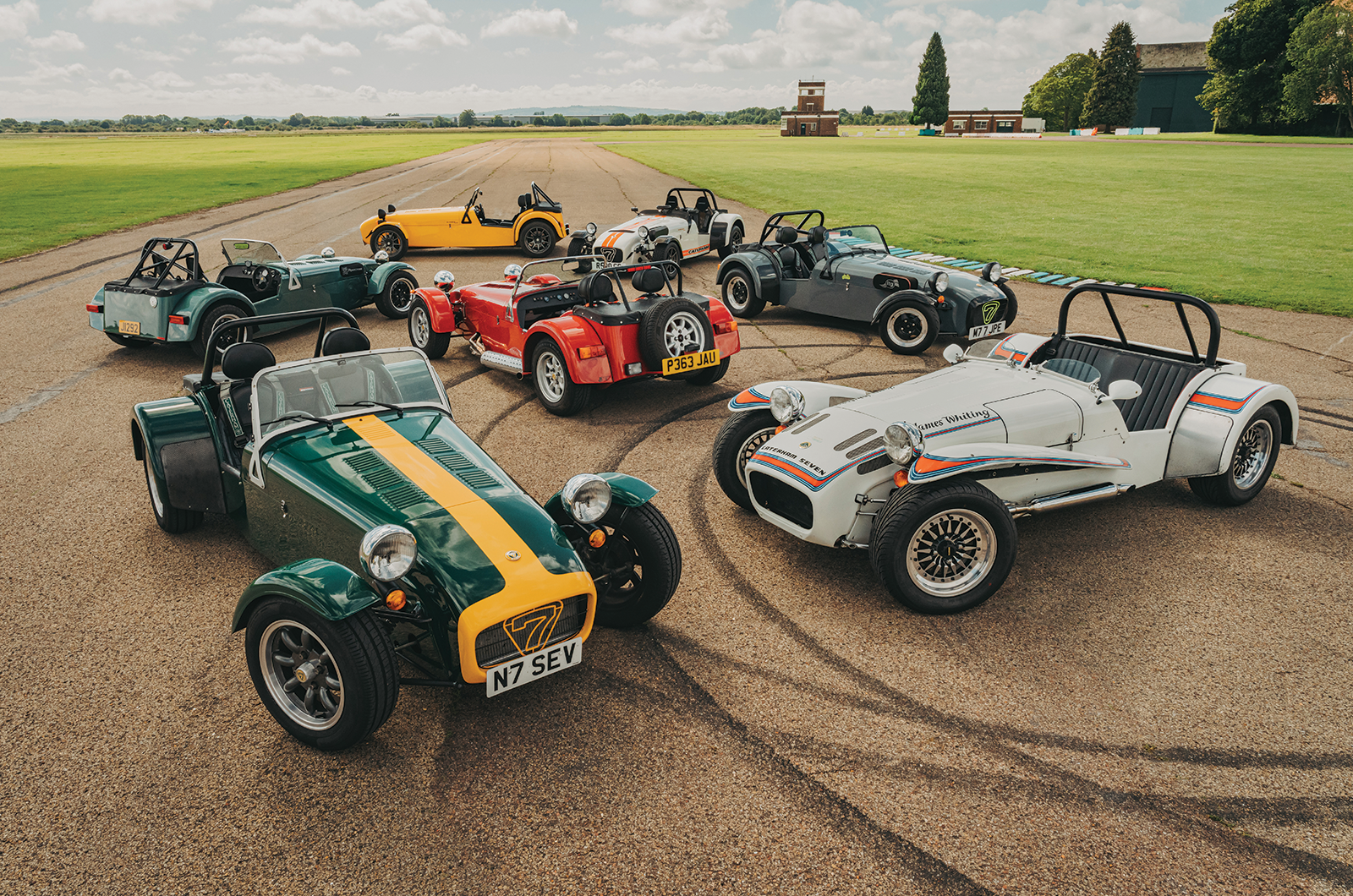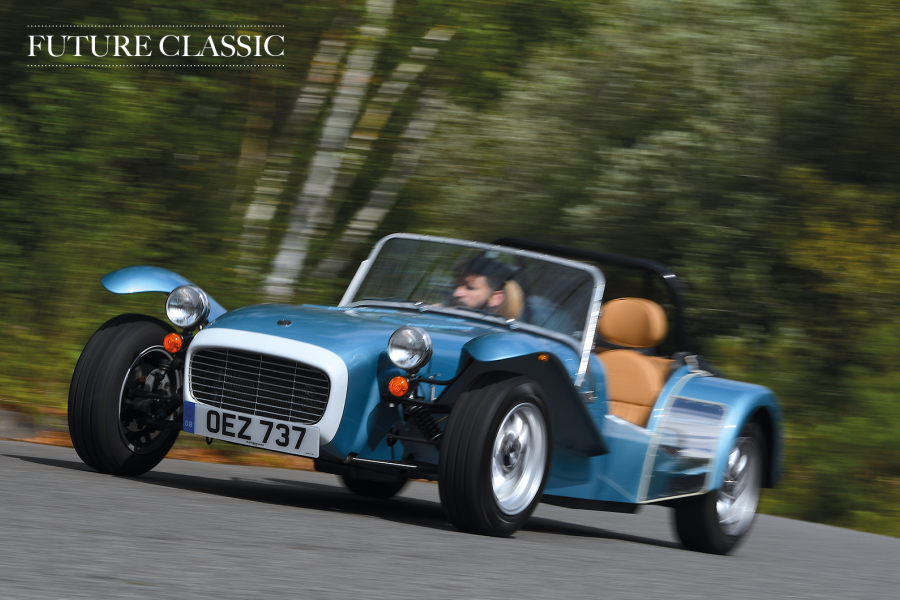In many ways it’s the archetypal Caterham: a live axle, a slick and peachy five-speed gearshift (arguably the best here), and a chassis that in general is benign and does a first-class job of signposting the car’s responses to your subtlest inputs.
Up the ante on track and the Classic Sprint’s mediocre performance (relatively speaking) results in a surfeit of grip over grunt, so a bold cornering approach is needed to achieve those period car-magazine drift shots.
But, as with all the cars here today, it never runs away from you, no matter how hard you provoke it.
The Caterham Seven JPE is tractable low down, but its manic peak power output is constrained by a tightly balanced, track-focused chassis
Talking to ex-Formula One driver Jonathan Palmer, who helped develop the JPE model we’re about to drive, he sums up perfectly the Caterham’s appeal: “It’s a Minimalist car – exhilarating and quick.
“You feel immediately when it starts to slide, because you’re sitting over the rear axle.
“The driving controls are straightforward, so people feel instantly familiar with them.”
Having started using Sevens at his PalmerSport track facility in 1992, Jonathan developed the JPE – or ‘Jonathan Palmer Evolution’ – with Caterham.
The Caterham Seven Roadsport Limited Edition 1.4 Supersport swapped the Ford 1.6 Supersprint engine for an uprated Rover K-series unit
It was a no-expense-spared project, with the Swindon Racing Engines 1998cc fuel-injected Vauxhall ‘red-top’ unit akin to those used in Vauxhall’s BTCC cars.
Producing 250bhp at 7750rpm, the engine alone was rumoured to cost £13,000 and in the JPE it generated 472bhp per tonne, meaning it could accelerate to 60mph from rest in a breathtaking 3.46 secs.
It went on to post a World Record 0-100mph-0 time of 12.6 secs.
The Roadsport’s more road-biased geometry lends it an accessible lightness at the expense of outright cornering grip at circuit pace
Dave Gwatkin has owned his stock JPE for three years.
With its subtle grey paintwork and contrasting dayglow-yellow badging and instruments, the car stands out even in this company.
Dymag magnesium wheels plus carbonfibre cycle wings and seats set it apart still further, as does the carbonfibre dressing the dash and gearknob.
Press the start button and the straight-cut gears of the Quaife ’box immediately make themselves heard as you accelerate away.
The Caterham Seven Roadsport Limited Edition has a removable Momo steering wheel
Subjectively, it’s the second-quickest car here, with surprisingly potent low-down tractability.
But when you think you’ve reached the JPE’s performance zenith, there’s more – and more.
The Vauxhall unit’s initial, guttural bark morphs into a frenzied scream at higher revs.
It sounds and feels ever so slightly unhinged as you push harder, until you realise that yet another layer of chassis brilliance has now come into play.
This Caterham Seven’s peaky 1.4-litre Rover K-series engine makes 128bhp and spins to 7600rpm
With no understeer, tighter body control than any of the other cars and a circuit-friendly high-speed balance, the JPE is inch-perfect and something to behold on this fast and technical course.
Contrasts don’t come much greater than swapping from the JPE to Andy O’Hara’s 1996 Roadsport Limited Edition.
Owned since 2018, this car is fitted with a Supersport engine – an uprated 1.4-litre Rover K-series.
Originally only available in 105bhp form for the standard Roadsport, the unit received reprofiled cams, a larger-bore inlet manifold and a remapped ECU to make 128bhp and increase redline revs to 7600rpm.
The Caterham Seven CSR200 is rapid but manageable
The development was crucial to Caterham, because it needed to replace the ageing Ford 1.6 Supersprint engine.
Also standard on the Roadsport Limited Edition were 14in Minilite wheels, a removable Momo steering wheel and gearshift indicators.
This is another Caterham that is clearly more road-biased, with Andy admitting that the car rarely ventures on track.
Its less aggressive steering and suspension geometry makes it feel lighter and more agile than the high-powered Sevens, although at 544kg there’s little difference in kerbweight.
The Caterham Seven CSR200 sports a flexible Ford Duratec engine
Body movements are marked versus the other cars, but you can imagine the liveliness of its chassis being entertaining on the road without needing to carry any great speed.
There is significantly less grip in corners, and you soon adopt a throttle-off approach to neutralise the inherent understeer.
The little Rover K-series is also quite peaky in this guise, so you need to work it hard to optimise the car’s performance.
When our penultimate Seven, the CSR200, arrived in 2005, it represented the biggest technical change in the model’s 32-year history.
The Caterham Seven CSR200 has the longer SV chassis, which better suits taller drivers
Using the SV’s 110mm wider, 150mm longer chassis, a boon for taller drivers, the CSR mirrored many of the modifications made for the SV-R race car.
Inboard pushrod front suspension was employed for less unsprung mass, and the cleaner airflow contributed to a 50% reduction in high-speed lift, while the front track also grew by 50mm, offering greater stability and grip.
For the first time, the Seven gained an independent rear end, with double wishbones and coils, which in turn allowed the chassis’ tubing to be strengthened, resulting in a 25% leap in torsional stiffness.
The Caterham Seven CSR200’s exhaust is relatively quiet (left); Formula One-style front suspension
Mechanically, Caterham’s ‘dirty’ Rover-based XPower engine was replaced by a cleaner 2.3-litre, 16-valve Cosworth-tuned Ford Duratec ‘four’, making, as the name suggests, 200PS (197bhp).
A more powerful CSR260 version was also available.
Ben Ferrey’s CSR, which he has owned for 18 months, shows how much scope there was at the time to bring the Seven into the 21st century without moving away from its essential ethos.
‘You balance the thrill of nailing the throttle against the pain inflicted on your ears: the R500 is savage in every respect’
I’m a mere 5ft 7in, so only just reach the pedals in the longer chassis, even with the seat moved forward.
On the track, the CSR is refined and perhaps the most undemanding of all the Sevens to drive.
Its Duratec motor is smooth, flexible and relatively quiet, save the odd fruity ‘pop-pop’ on the overrun, and the six-speed ’box’s gearing is taller than that of most the others.
It’s still unarguably quick, but the CSR’s markedly higher grip levels, lower-geared steering and tighter overall body control make it the least frenetic Seven to drive.
At its launch, the maximum-attack Caterham Superlight R500 represented peak Seven
Which is not an accusation you’d level at our final Seven, the Superlight R500.
At launch in 2008, this was the performance pinnacle of the Seven series, sitting above the 120, 150, 300 and 400 models in the Superlight range.
Caterham replaced the previous K-series VHPD-powered R500 and once again used the Duratec engine, this time 1999cc with a cylinder head fettled by ex-F1 engineer Simon Armstrong and the addition of roller-barrel throttle bodies to produce a spectacular 263bhp at 8500rpm – and, more importantly, a power-to-weight ratio of 520bhp per tonne.
True to its ‘Superlight’ moniker, the R500 gained a lighter-weight chassis mated to a carbonfibre nose cone and cycle wings to achieve a kerbweight of just 506kg.
The Caterham Seven Superlight R500’s tuned Duratec engine gives 263bhp
Optional kit included a Caterham Motorsport-engineered six-speed sequential gearbox that cost an eye-watering £2950.
And it’s that transmission that we’re just coming to terms with in this Caterham Cars-owned R500, the very car in which ‘The Stig’ achieved that barely-believable 1 min 17.9 secs lap around the Top Gear track in 2008, beating the Bugatti Veyron 16.4’s time.
Sitting in the unpadded carbon-Kevlar driver’s seat, you face a simple Stack digital instrument panel and not much else.
Using the clutch to move away – it’s not needed for upchanges, when just a slight lift is required – the acceleration is vicious.
A focus on weight reduction helped the R500 to achieve 500bhp per tonne
With no insulation, the open cockpit heats up quickly, and you inwardly balance the thrill of nailing the throttle hard against the pain inflicted on your ears: the R500 is utterly savage in every respect.
Bash through the gears – back for upshifts, forwards for down – and beyond 7500rpm it gets a second wind all the way to 9000rpm.
At that point your commitment needs to be absolute, the more so because your vision is impaired by the carbonfibre ’screen and (as I’m told later) grip by this car running on 10-year-old rubber.
Yet, despite offering a huge surfeit of power over grip, the R500 remains just as exploitable and faithful to driver inputs as any other Seven.
Given the model’s lairy reputation, I can’t think of any better testament to the brilliance of Caterham’s diminutive legend.
Images: Max Edleston
Thanks to: Caterham Cars; James Whiting Sevens; Bicester Heritage; Richard Nichol, the Caterham & Lotus Seven Club
Factfiles
Caterham Seven Twin Cam
- Sold/number built 1974-’83/313
- Construction aluminium body with stressed panels, tubular steel chassis
- Engine iron-block, alloy-head, dohc 1558cc ‘four’, twin Weber 40DCOE carburettors
- Max power 126bhp @ 6500rpm
- Max torque 113lb ft @ 5500rpm
- Transmission four-speed manual, RWD
- Suspension: front independent, by lower wishbones, anti-roll bar as upper wishbones rear live axle, A-frame, trailing links; coil springs, telescopic dampers f/r
- Steering rack and pinion
- Brakes discs front, drums rear
- Length 11ft 1in (3380mm)
- Width 5ft 2in (1575mm)
- Height 3ft 8in (1115mm)
- Wheelbase 7ft 3in (2225mm)
- Weight 1102lb (500kg)
- Mpg 20
- 0-60mph 7 secs (est)
- Top speed 109mph
- Price new £3700 (1977)
- Price now £25,000*
Caterham HPC 1700
- Sold/number built 1986-’95/62
- Construction aluminium body with stressed panels, tubular steel chassis
- Engine iron-block, alloy-head, dohc 1699cc ‘four’, twin Weber 45DCOE carburettors
- Max power 170bhp @ 6500rpm
- Max torque 140lb ft @ 5500rpm
- Transmission five-speed manual, RWD via limited-slip differential
- Suspension: front independent, by double wishbones rear de Dion axle, A-frame, radius arms, anti-roll bar; coil springs, telescopic dampers f/r
- Steering rack and pinion
- Brakes discs
- Length 11ft 1in (3380mm)
- Width 5ft 2in (1575mm)
- Height 3ft 8in (1115mm)
- Wheelbase 7ft 3in (2225mm)
- Weight 1300lb (590kg)
- Mpg n/a
- 0-60mph 5 secs (est)
- Top speed 120mph
- Price new £12,000 (1986)
- Price now £25-35,000*
Caterham Classic Sprint 1600
- Sold/number built 1992-’98/n/a
- Construction aluminium body with stressed panels, tubular steel chassis
- Engine all-iron, ohv 1598cc ‘four’, twin Weber 40DCOE carburettors
- Max power 100bhp @ 6000rpm
- Max torque 105lb ft @ 5200rpm
- Transmission five-speed manual, RWD
- Suspension: front independent, by lower wishbones, anti-roll bar as upper wishbones rear live axle; A-frame, coil springs, telescopic dampers f/r
- Steering rack and pinion
- Brakes discs front, drums rear
- Length 11ft 1in (3380mm)
- Width 5ft 2in (1575mm)
- Height 3ft 8in (1115mm)
- Wheelbase 7ft 3in (2225mm)
- Weight 1200lb (625kg)
- Mpg 34
- 0-60mph 6.5 secs (est)
- Top speed 110mph (est)
- Price new £7450 (1600GT)
- Price now £10-15,000*
Caterham JPE
- Sold/number built 1992-2001/53
- Construction aluminium body with stressed panels, carbonfibre wings, tubular steel chassis
- Engine iron-block, alloy-head, dohc 1998cc ‘four’, Weber Alpha electronic fuel injection
- Max power 250bhp @ 7750rpm
- Max torque 186lb ft @ 6250rpm
- Transmission Quaife straight-cut five-speed manual, RWD
- Suspension: front independent, by double wishbones rear de Dion axle, A-frame, radius arms, anti-roll bar; coil springs, telescopic dampers f/r
- Steering rack and pinion
- Brakes ventilated front, solid rear discs
- Length 11ft 1in (3380mm)
- Width 5ft 2in (1575mm)
- Height 3ft 8in (1115mm)
- Wheelbase 7ft 3in (2225mm)
- Weight 1168lb (530kg)
- Mpg n/a
- 0-60mph 3.46 secs
- Top speed 150mph
- Price new £37,000
- Price now £40-50,000*
Caterham Roadsport Limited Edition 1.4 Supersport
- Sold/number built 1996/n/a
- Construction aluminium body with stressed panels, tubular steel chassis
- Engine all-alloy, dohc 1397cc ‘four’, multi-point fuel injection
- Max power 128bhp @ 7400rpm
- Max torque 100lb ft @ 5000rpm
- Transmission six-speed manual, RWD
- Suspension: front independent, by double wishbones rear de Dion axle, A-frame, radius arms; coil springs, telescopic dampers f/r
- Steering rack and pinion
- Brakes discs
- Length 11ft 1in (3380mm)
- Width 5ft 2in (1575mm)
- Height 3ft 8in (1115mm)
- Wheelbase 7ft 3in (2225mm)
- Weight 1200lb (544kg)
- Mpg n/a
- 0-60mph 6 secs
- Top speed 114mph
- Price new n/a
- Price now £14,500-15,500*
Caterham CSR200
- Sold/number built 2005-’11/196 (est)
- Construction aluminium body with stressed panels, tubular steel chassis
- Engine all-alloy, dohc 2261cc 16v ‘four’, electronic fuel injection
- Max power 197bhp @ 6000rpm
- Max torque n/a
- Transmission six-speed manual, RWD
- Suspension independent, at front by double wishbones, coil springs with inboard pushrods, telescopic dampers rear double wishbones, coil-overs
- Steering rack and pinion
- Brakes discs
- Length 12ft 6in (3530mm)
- Width 5ft 6in (1685mm)
- Height 3ft 8in (1115mm)
- Wheelbase 7ft 6in (2305mm)
- Weight 1267lb (575kg)
- Mpg 27.5
- 0-60mph 3.7 secs
- Top speed 140mph
- Price new £31,000
- Price now £33-35,000*
Caterham Superlight R500
- Sold/number built 2008-’14/176
- Construction aluminium and carbonfibre body with stressed panels, tubular steel chassis
- Engine all-alloy, dohc 1999cc 16v ‘four’, electronic fuel injection with roller-barrel throttle bodies
- Max power 263bhp @ 8500rpm
- Max torque 177lb ft @ 7200rpm
- Transmission six-speed sequential manual, RWD via limited-slip diff
- Suspension: front independent, by double wishbones rear de Dion axle, A-frame, radius arms, anti-roll bar; coil springs, telescopic dampers f/r
- Steering rack and pinion
- Brakes discs
- Length 10ft 2in (3100mm)
- Width 5ft 2in (1575mm)
- Height 3ft 8in (1115mm)
- Wheelbase 7ft 3in (2225mm)
- Weight 1115lb (506kg)
- Mpg n/a
- 0-60mph 2.9 secs
- Top speed 150mph
- Price new £36,995
- Price now £40-45,000*
*Prices correct at date of original publication
Enjoy more of the world’s best classic car content every month when you subscribe to C&SC – get our latest deals here
READ MORE
21 classic great British kit cars
Lotus Six: flyweight flyer
Your classic: Lotus Seven (Fiat twin-cam)
Simon Hucknall
Simon Hucknall is a senior contributor to Classic & Sports Car
